


We're ready to serve your best interests in legal disputes. We provide a ordable consultation & representation.






We're ready to serve your best interests in legal disputes. We provide a ordable consultation & representation.


September 2023, Issue 259
Published: September 1, 2023
Publisher Dr. Shin Gyonggu
Editor-in-Chief Dr. David E. Shaffer


Managing Editor William Urbanski
Chief Copy Editor Isaiah Winters
Layout Editors Kim Sukang
Photographer Kim Hillel Yunkyoung
Online Editor Kim Sukang
The Gwangju News is the first English monthly magazine for the general public in Korea, first published in 2001. Each monthly issue covers local and regional issues, with a focus on the roles and activities of the international residents and local English-speaking communities.
Copyright ©2023 by the Gwangju International Center. All rights reserved. No part of this publication covered by this copyright may be reproduced in any form or by any means – graphic, electronic, mechanical, photocopying, recording, or otherwise – without the written consent of the publisher.

The Gwangju News is published by the Gwangju International Center: Jungang-ro 196-beon-gil 5 (Geumnam-ro 3-ga), Dong-gu, Gwangju 61475, South Korea

Tel: (+82)-62-226-2733 Fax: (+82)-62-226-2731
Website: www.gwangjunewsgic.com
Email: gwangjunews@gic.or.kr
gwangjunews gwangju_news
Registration No. 광주광역시 라. 00145 (ISSN 2093-5315)
Registration Date: February 22, 2010
Printed by Jieum 지음 (+82)-62-672-2566
For volunteering and article submission inquiries, please contact the editor at gwangjunews@gic.or.kr.
AsI am working on the proofs for this issue’s Gwangju News, I feel an uncharacteristic coolness in the breeze floating in through my window. I realize that I am not in need of the services of my trusty fan that has been working overtime for the past three months. And when peering out that window, I notice the redness of crepe-myrtle (백일홍나무) in full bloom almost everywhere. It suddenly dawns on me that I am working on the September issue of our magazine, and that it is September that ushers in the autumn season!
A lot is happening this fall, and the Gwangju News aims to keep you abreast of the major events. We start off this issue with an interview with one of the center-stage speakers at next month’s World Human Rights Cities Forum (WHRCF), one of Gwangju’s annual showcase events. Dr. Olivier De Schutter is the UN Special Rapporteur on Extreme Poverty, and he was kind enough to make time for a question-and-answer session with the Gwangju News. Not familiar with the WHRCF? Our second feature is a great introduction to the Forum, what past Forums have provided, and what this year’s WHRCF has on offer.
There is no need to wait until October’s WHRCF, however, for a major Gwangju event: The Gwangju Design Biennale opens its curtains on September 7 for a two-month show. To let you know what this year’s Design Biennale is all about, the Gwangju News brings you an interview with it’s general director, Ken Nah.
This month’s Political Focus is on the climate crisis and how little the world seems interested in saving Earth, and humanity, from any semblance of life as we know it. It analyzes why nations can’t seem to get their act together, though it is urgently necessary that they do so. Still interested in getting in one last dip in the aqua this year but not interested in going to a crowded, noisy, littered beach. Check out our Lost in Honam article for some tips on secluded, quiet, and pristine mountain streams that you can wade in, dive in, or just chill in. Interested in traveling farther? Check out our managing editor’s trip to Kota Kinabalu (that’s on Borneo).
These articles are just the tip of the iceberg; they merely scratch the surface of what our September issue has waiting for you – culture and arts, teaching and learning, and all your favorites!
Stay health-conscious, enjoy the season, and enjoy September’s Gwangju News!
Special thanks to Gwangju City and all of our sponsors.
David E. Shaffer Editor-in-Chief GwangjuNews

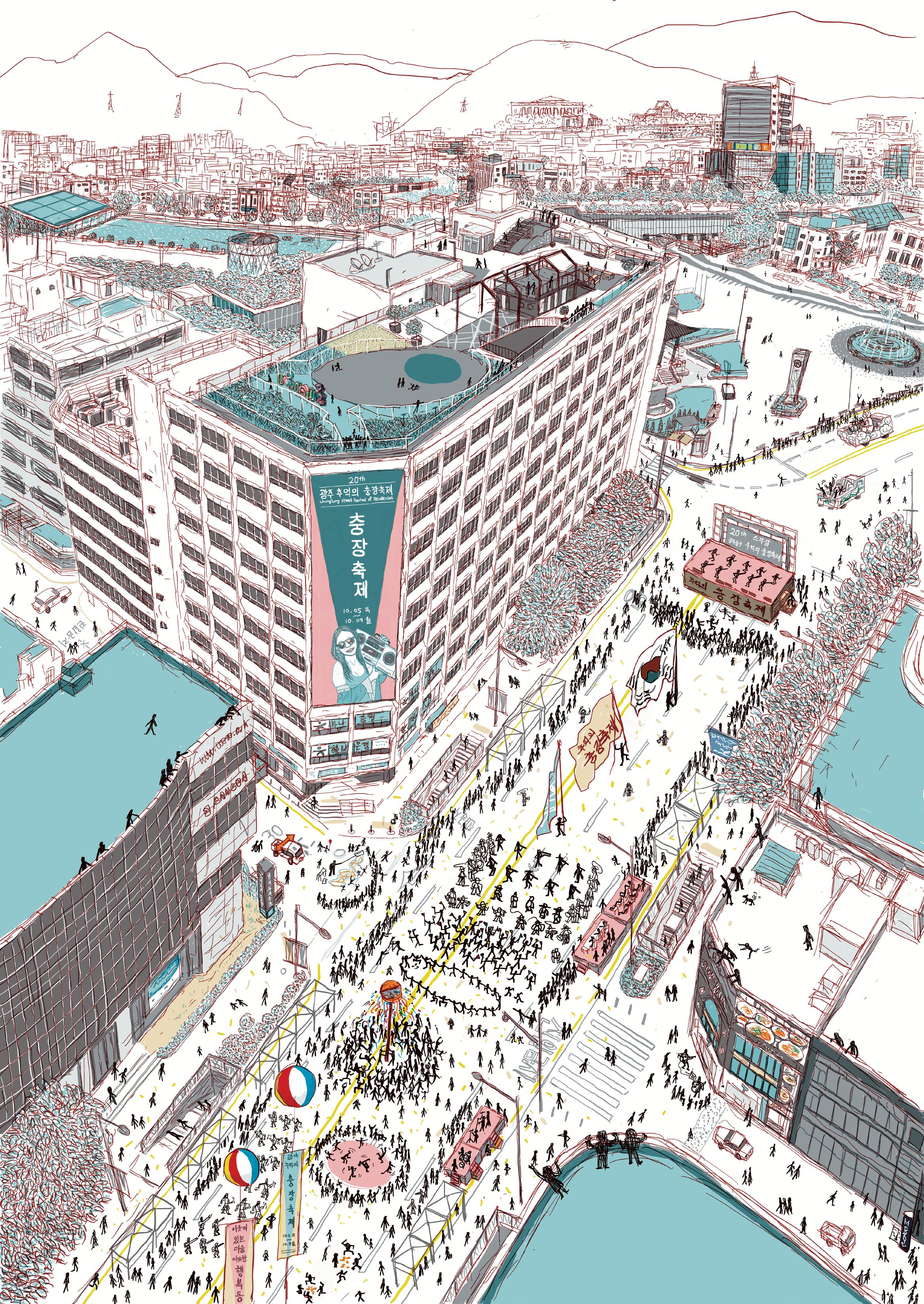


01 From the Editor
04 Gwangju City News features



06 Interview with the 2023 WHRCF Keynote Speaker: Olivier De Schutter
10 The “World” and “Human Rights”: The WHRCF
14 Gwangju Design Biennale: Interview with General Director Ken Nah travel
18 Tale of Two Valleys: Swimming Deep in the Mountains of Gokseong community
23 Your Name Is Wind, Wind, and “Nice Windy Day”
26 Dr. Diet, Dr. Quiet, and Dr. Merryman!
28 Kota Kinabalu: Flew to Borneo Last July and Boy Are My Arms Tired
32 Political Focus: The Burning House
38 Culture Exchange: Teaching Culture Classes at Unri Middle School
40 The Connection Between “Cosmic Education” and the Imagination

Kwangju Christian Hospital (KCH) is opening the Public Late Night Children’s Hospital from September 1, 2023, to December 31, 2025. The Public Late Night Children’s Hospital will be open on weekdays from 6:30 p.m. to 12:00 a.m. and on weekends and holidays from 8:30 p.m. – 12:00 a.m. Six pediatricians will stay at the Public Late Night Children’s Hospital, and Gwangju Metropolitan City plans to hire three more pediatricians. Gwangju City will designate a night pharmacy near the KCH so that patients can buy medicine after medical treatment at night.
Kwangju Christian Hospital website: http:// www.kch.or.kr; Phone: 062-650-5000.
Source Jeong, D. (2023, July 5). “밤 12시까지 소아과 진료”…
광주기독병원 의사 6명 전담 [“Pediatric care until 12:00 at night”… Kwangju Christian Hospital 6 doctors assigned]. The Hankyoreh. https://www.hani.co.kr/ arti/area/honam/1098835.html
The Gwangju Municipal Library (Mudeung, Sansu, and Sajik branches) is opening cultural lectures for adults and children from September to November. The Mudeung and Sansu Libraries offers classes for adults such as Korean calligraphy (서예), Korean painting (한국화), Korean folk art (민화), and botanical art. Sajik Library offers classes for children, such as making picture books. There is no tuition fee. The cost of textbooks and materials varies by course.
For more information on the classes and registration, visit the Gwangju Municipal Library website (https://citylib.gwangju.kr).
Source Gwangju Metropolitan City. (2023, August 9). 광주시립 도서관, 하반기 22 개 문화강좌 운영 [Gwangju City Library, holding 22 cultural lectures in second half of this year]. https://gwangju.go.kr
Health authorities decided to downgrade the COVID-19 infection classification level to the lowest, Class 4, from the current Class 2 on August 31, as the virus situation has stabilized.
The decision means that the government will manage the infectious disease like the seasonal flu, lifting nearly all antivirus curbs and no longer counting the number of new daily cases that have continued for the past three years and seven months.
The government will shift its focus to protect high-risk groups of people such as the elderly, young children, and patients. While conducting preemptive inspections in nursing hospitals and facilities, support for examinations and hospitalization costs for high-risk groups will remain the same. The designation of “respiratory patient treatment center,” which has been operating until now, will be lifted, and it will be converted to hospitals nationwide treating COVID-19 outpatients.
In addition, as all services such as medical counseling and administrative information centers’ home treatment support are terminated, daily living subsidies and paid vacation expenses will also be terminated. On the other hand, support for treatment and vaccines across the country is currently being maintained.
The National Cabinet passed an enforcement decree on August 8 to facilitate efforts to relocate the military airport in Gwangju, the Defense Ministry said. The decrees on the relocation projects will come into effect on August 26 following the promulgation of related special acts on April 25, according to the Ministry. One of the decrees entails support measures for the relocation of the military airport in Gwangju, such as procedures for the central government to provide financial support if costs exceed the budget.
The special acts include mandatory support projects such as migration measures, livelihood measures, transportation network expansion, the creation of a hinterland industrial complex, and exemption from conducting preliminary feasibility studies for projects supporting relocation areas. One project seeks to build a new airport nearby in South Jeolla Province, although the exact site has yet to be determined. The project aims to open the new integrated airport in 2030.
Sources
Gwangju Metropolitan City. (2023, July 18). 국방부, 광주군공항특별법 시행령안 재입법예고 [Ministry of National Defense, notification of enforcement decree of Gwangju Military Airport Special Act].
https://www.gwangju.go.kr
Korea Times. (2023, August 8). Cabinet passes enforcement decrees on relocation of 2 military airports. https://www.koreatimes.co.kr/www/ nation/2023/08/113_356589.html
https://www.gwangju.go.kr
Summaries and translations by Kim Sukang and Kook Hyuna.
Delivering the keynote speech at the plenary session of the 13th World Human Rights Cities Forum is Dr. Olivier De Schutter, the UN Special Rapporteur on Extreme Poverty. For the Gwangju News, Chiarella and De Schutter corresponded on the conference’s themes.

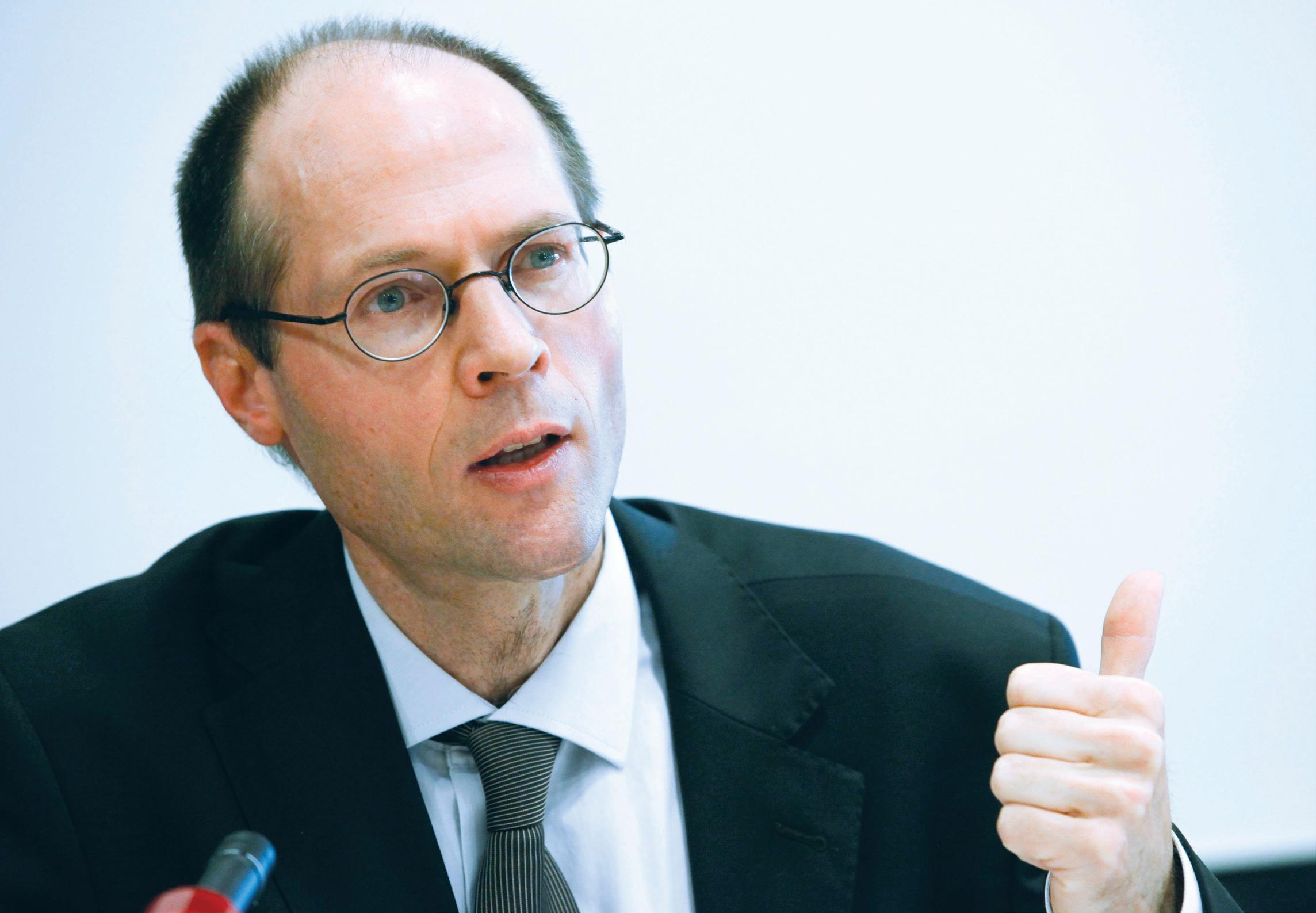
Jonathan Joseph Chiarella (JJC): How do poverty and the “right to development” relate to human rights? How do you make human rights go beyond simply being free from interference?
Olivier De Schutter: Governments should not only allow people certain freedoms – to express themselves, to exercise a religion, or to have a family life. They also should provide services and social protection allowing people to lead decent lives. The two are closely connected, however. Governments that are not accountable to the population will not work for the population and will not prioritize what’s in the public interest.
[The government should provide services (e.g., housing, jobs) to empower the public, because only if the public is empowered will the government serve the public. – JJC]
JJC: After the 2008 Financial Crash, larger organizations like the European Union implemented “austerity” policies. How do “austerity” policies hurt local governments?
Olivier De Schutter: There is now a widely shared consensus that the reaction to the 2008–2009 financial crisis, in the EU and elsewhere, was inappropriate. The rise in public deficits resulting from bailing out major financial institutions to rescue the financial system was followed by policies intended to swiftly reduce the public debt and thus to reassure the markets, but all too often this was done too early and at a huge cost to the population.
Greece was particularly affected, with successive bailouts that were provided against a commitment to downsize public services, including in crucial sectors such as health and education. … It took ten years for Greece to recover from that shock. This shows the need to carefully assess the human rights impacts of such economic reforms when designing and implementing them. Local governments, who are at the frontline of service delivery and in direct contact with the population, should be involved in such assessments to avoid
destructive impacts on the ability of people to live decent lives.
JJC: How can local organizations improve the lives of their citizens – even when the country’s GDP is not growing?
Olivier De Schutter: The right to development is not about creating the conditions for GDP growth. Quite to the contrary, in fact. It is about ensuring that governments put the well-being of people and the realization of human rights above economic growth.
This was the message of the UN General Assembly when it adopted the Declaration on the Right to Development in 1986, and this was the intention of … the Human Development Report series by the UNDP in 1990, strongly inspired by the work of [Indian economist] Amartya Sen.
Local governments are therefore essential to the realization of the right to development, since they are often leading in areas such as health, education, housing, or the building of rural infrastructures. In my country missions, I have often witnessed local governments as redirecting development towards ensuring the population’s well-being, while central governments try to create the conditions for economic growth (through macroeconomic policies, trade agreements, incentives to foreign investors, etc.
JJC: What is it like fighting for human rights as a Special Rapporteur at the UN?
Olivier De Schutter: This is a unique position from which to advocate for change. On the one hand, because it is an unpaid position (I am not a public servant of the UN), I have no fear of displeasing anyone – I do not fear losing my job or failing to get promoted – which allows me to be very frank in my assessments. On the other, I have the support of the UN and the international community. Special Rapporteurs of the UN Human Rights Council are the “eyes and ears”
of the international community, since they report back to governments sitting on UN bodies. I therefore routinely find myself having to state findings or to encourage reforms which many parts of the UN system share and encourage but cannot express as candidly.
JJC: Globalization can make anti-corruption and anti-poverty missions difficult, but globalization can provide unique benefits, too. How should we use globalization?
Olivier De Schutter: Globalization can be a powerful tool for poverty reduction and for the realization of human rights, but it should be a means to an end, rather than an end in itself. Trade should be linked to compliance with environmental standards and labor rights in order to encourage a race to the top rather than a race to the bottom. Investment should be a tool to support local communities rather than a way to increase the profits going to shareholders. Transnational corporations should pay decent wages and their fair share of taxes rather than exploiting workers in low-wage jurisdictions and practicing aggressive tax optimization strategies as they do with price
transfer mechanisms or declaring profits in tax havens. … Globalization should be tamed if it is to become a tool for human rights-based development.
JJC: Describe the relationships that the UN has with localities.
Olivier De Schutter: The UN has traditionally worked with national governments. It is only recently, over the past decade or so, that it has come to acknowledge the important role of cities and local governments in the realization of human rights.
This evolution is essential, however. There are often too many veto points within central governments and too many opportunities for capture of decision-making by corporate actors. In contrast, opportunities for direct participation and accountability towards the people are much more significant at the local level. Moreover, local governments are better placed to ensure adequate coordination between different policy areas to ensure a coherent approach to societal challenges. It should therefore come as no surprise that the

center of gravity of political innovation is now shifting to cities and local governments. The UN can encourage this by encouraging the sharing of good practices and by encouraging central governments to see this as an opportunity. [Central governments] should enable cities and local governments rather than impede them or see the growing role of these actors as a threat.
JJC: How can local actors best promote human rights amid the calamity of severe poverty?
Olivier De Schutter: Poverty has often been addressed by combining economic growth with redistribution: Growth is meant to finance public services and social protection through progressive forms of taxation. This approach is insufficient. We need to also address poverty [through] pre-market measures rather than only [through] post-market redistribution.
… We need to build an inclusive economy that works for all. We should simply compensate the losers of an extractive type of economy. This approach also makes us less dependent on [economic] growth, which is seen less and less as desirable due to the enormous metabolism of energy and matter required….
JJC: How can we make solidarity among various people and places become real?
Olivier De Schutter: “Solidarity” is a widely underused but powerful idea in the UN’s work. It is a way of recognizing that we are interdependent and that no group, no country, no actor will improve its own situation sustainably unless the needs of others are taken into account.
Countries extracting resources from other countries through unfair trade deals or by failing to tackle abuses by corporations will create the conditions for failed states that could provide a haven for terrorists, lead to the radicalization of the youth, or encourage large-scale migratory flows. Buyers in global supply chains that cheat their suppliers or encourage these suppliers to underpay their workers may soon lose these suppliers or see them go bankrupt, and so on.
Ultimately what is key is to recognize that no actor can improve his position at the expense of others. That is solidarity. It is the opposite of policies focused on short-term gains and on extraction.
JJC: Market laws of land ownership and housing can make equality difficult to achieve. How have some cities or counties successfully achieved a fairer distribution of property?
Olivier De Schutter: Cities, but also local governments in rural areas, are increasingly rediscovering commons-based approaches to the management of resources such as land, water, and forests, but also of institutions such as healthcare or education. What this means is that such resources or institutions should be governed democratically, by the users themselves, rather than through the diktats of central governments or by private actors driven by profit-seeking motives. Beyond bureaucracy and markets, the commons are a far more sustainable way of governing resources and institutions: [They are] more focused on people’s needs, better informed by their lived experiences, more attentive to long-term sustainability, and empowering rather than dis-empowering.
[One can also see that individualized consumption does not serve the needs of the masses nor our environments. If one applies this to Korea, the competitions for personal qualifications (“specs”) and product accumulation make daily life less accessible overall. However, the more opportunities and benefits that are in the commons, the less that the downsides of the market can cause damage. The more public services we have for the poor, the more democratic our societies will be. Local governments are on the “front line” of this struggle. Speakers at this year’s Forum will share stories of hardship and success from all over the world. — JJC]
AuthorJonathan J. Chiarella grew up in New York. He holds a BA in history (Rochester) as well as two MAs (Chonnam, Florida) and a PhD in politics (Florida). You can spot him riding the river trails or read his analysis of current affairs related to Honam or international relations.

Gwangju will host its 13th World Human Rights Cities Forum from October 4 to 7 at the Kimdaejung Convention Center. This year focuses on the poverty and inequalities that make realizing human rights impossible. To highlight the crisis: 600 million people will live in extreme poverty by 2030. The recent pandemic shows how inequalities in damage and recovery go far beyond one person having a nicer television than his neighbor. Jobs, lives, vaccine distribution, and even the economic and social fabric of entire communities are on the line.

The WHRCF has been bringing together speakers and attendees from various parts of the world to discuss its themes every year since the fall of 2011. Leaders and experts gather to discuss, debate, and share the actions that cities and local NGOs have taken to make life fairer for all of their residents.
Past speakers have shared success stories with town planning and outreach programs to make their cities more accessible and safer for everyone. The case of Utrecht (Netherlands) can provide a good example to follow. Another speaker may talk of her country’s shortcomings and where work needs to be done, such as the disconnect between the law and its implementation. (The ability of victims to go after their attackers correlates with wealth, which is intuitive but not always obvious for those fortunate enough to not have to deal with such scenarios. )
All participating mayors, representatives, and officials agree to a charter on what a human rights city will be and, by sharing their experiences formally (and in informal face-to-face contexts, too, of course), will thereby try to realize the goal of solidarity. The 2018 program in particular, with its concern on diversity and inclusiveness, made this dream less cynical. Speakers called out double standards regarding how society chooses which forms of “international-ness” to highlight. The national dimensions of activists’ struggles are unavoidable, but the local government focus of the conference ensures that the representativeness is not limited to the wealthiest and most prominent within given regions.
The human rights-focused May 18th organizations got the ball rolling. The GIC, however, took up organizing responsibilities in 2014, which was not the obvious move, but GIC Director Shin Gyonggu dismissed concerns of mission creep and actively rejected compartmentalization. The WHRCF has grown ever larger and has achieved official and true international status. In the inaugural year, a representative for the UN High Commissioner for Human Rights relayed special remarks. Later, however, UN notables gave keynote speeches themselves, and since 2020, the OHCHR and UNESCO started co-hosting the event. The UN Secretary-General himself opened the forum in 2021. This year's keynote speaker at the plenary session will be another UN heavyweight, Olivier
De Schutter, who is the UN Special Rapporteur on Extreme Poverty and Human Rights. This is especially relevant for 2023’s theme. [See page 6, this issue, for an interview with Olivier De Schutter.]
The event’s continuing success should be an antidote to the compulsive trend of adding “world” and “international” to events. The international component is both substantial and always thematically relevant. Co-organizing has been a committee that is part of the Spain-based United Cities and Local Governments. In 2016, the Raoul Wallenberg Institute in Sweden joined in.
The relevance of the other component of the forum – “human rights” – to both poverty and to Gwangju may not be apparent at first glance. Remember that the May 18th Uprising encompassed both “negative” and “positive” rights. The movement was not simply against martial law and the arbitrary violence of Chun’s coup government. It was also for democracy. Demonstrators demanded access to the ballot. This would make them citizens and not passive subjects, and having a say in your community’s

destiny sounds like a human right. That momentous week in May also showed solidarity and mutual help, particularly in transport, food, and medical care. All of this took place in a region that was markedly poorer and neglected in comparison to the home region of dictators like Park Chung Hee and Chun Doo Hwan, who were from Gyeongsangbuk-do. When one considers how being poor in a free market society can rob people of power, then Gwangju, human rights, and this year’s theme all connect.
The event provides a venue for activists, politicians, NGOs, politicians, and intellectuals to all meet and discuss the on-the-ground struggles, the research that syntheses these struggles, and the difficult academic questions of what rights are, who is entitled to them, and how we go about defining and defending them. Human rights are a guiding goal, not a signpost we can arrive at and declare mission accomplished. In this ongoing struggle, the WHCRF is a valuable venue for forging links and sharing ideas among the leaders of tomorrow and of today.
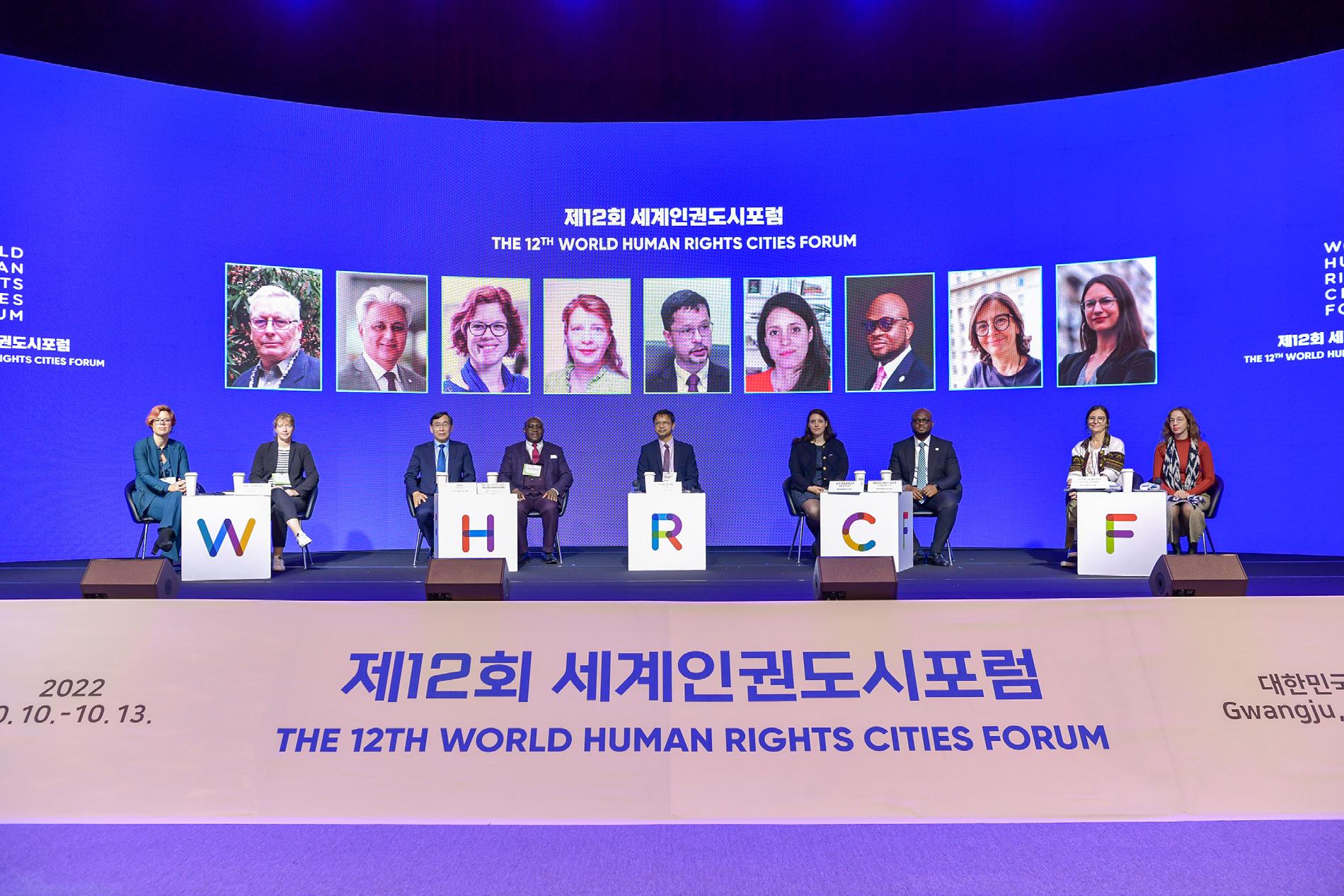
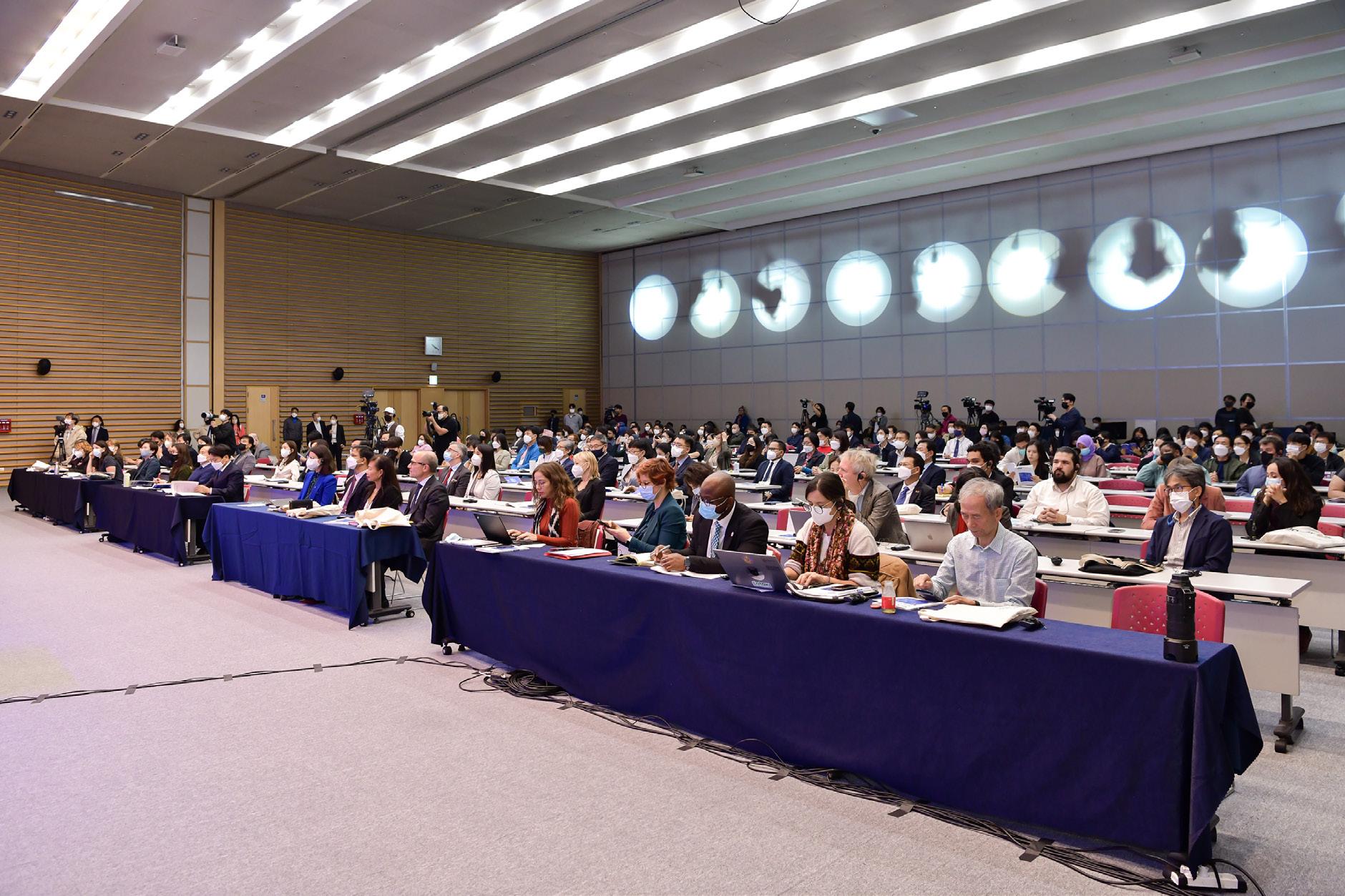
 By the Gwangju News
By the Gwangju News
It’s that time of year again: time for the annual Gwangju Design Biennale. This year’s twomonth-long exposition runs from September 7 to November 7. The general director of this year’s decennial exhibition is Ken Nah, and the Gwangju News was fortunate to be able to catch up with him for the following interview just prior to the opening of the Design Biennale. — Ed.
Gwangju News (GN): On October 4, 2022, you were appointed as the general director of the tenth Gwangju Design Biennale (GDB) set for 2023, and the GDB is about to open. What was the motivation for you to accept the position as general director of the GDB?
Ken Nah: I already participated several times in exhibitions and conferences of the last editions of the GDB. As a scholar who researches design, it is a great opportunity to be the general director of the GDB, which presents the value and philosophy of design. The GDB is a venue for discourse on the design of the past, present, and future.
GN: You have an academic background in industrial engineering and engineering design, and now are a professor and director of Hongik University’s Graduate School of International Design. You do various design projects between engineering and art. As a “confluent” person who freely crosses boundaries, what is the value of the GDB?
Ken Nah: This year marks the tenth anniversary of the GDB. Throughout a decade, it has become a representative design event in Asia. I think it is the pride of Gwangju and Korea to have continued international events under the theme of “design.” There are many exhibitions with the theme of “design,” but most of them tend to be industrial exhibitions such as fairs. In terms of this, the Design Biennial makes a distinction. I believe it is an important value of the GDB to present a future vision through design and a forum for discourse that fits the trends of the times. I have faith that design is not only about the competitiveness of corporations but also of cities and nations. I would like to pursue capturing the essential value of convergence, reflecting the present and future trends of design through the GDB.
GN: On September 6, the GDB will open under the theme “Meet Design.” What is the reason that “Meet Design” was chosen as the theme for this year?
Ken Nah: Design converges with other areas such as technology, culture, life, and business. In this sense, “design” and “convergence” share indistinguishable attributes. When things converge thoroughly, the results come out good. So, “Meet Design” was chosen as the theme of the GDB considering such attributes.
GN: What is the biggest differentiation between this year and the last editions of the GDB?
Ken Nah: There needs to be a differentiation between the design biennale and the art biennale rather than between the current GDB the last editions of it. The reason is, people still confuse the art biennale and the design biennale because these two use the same name “biennale.”
I have faith that design is not only about the competitiveness of corporations but also of cities and nations.
Connectivity with business is one of the important characteristics of the GDB. This characteristic distinguishes the GDB from the art biennale.
Connectivity with business is one of the important characteristics of the GDB. This characteristic distinguishes the GDB from the art biennale. The convergence of design and business is more clarified in this year’s exhibition. In addition, the GDB has always been decorated with new events because the theme and exhibition contents of each event are different.
GN: The four sub-themes of the main exhibition are “Technology,” “Lifestyle,” “Culture,” and “Business.” What is the reason that these four sub-themes were chosen, and how is the main exhibition constructed?
Ken Nah: Convergence is the essential value of design. In light of the rapid development of technologies such as AI and the postCOVID-19 era, the roles of esign and convergence are becoming very important. Therefore, I wanted to focus on technology, lifestyle, culture, and business, which are closely related to our lives, industries, and society. The GDB consists of these four thematic exhibitions, and each exhibition
shows how closely design is connected to human life.
GN: Can you introduce other programs that citizens visiting GDB can enjoy in addition to viewing the exhibition?
Ken Nah: Visitors to the GDB are very diverse when it comes to their age and occupation, so as a way to evoke empathy and satisfaction from visitors, various events have been prepared. At the Design Biennale Exhibition Hall, you can enjoy things like the “Kakao Experience Zone,” the “Design Biennale with Metaverse,” the “Children’s Design Education Program,” and the “Design Workshop with Designers.” There will also be a variety of things to buy, like design products and goods in design markets.
GN: This year is the tenth anniversary of the GDB. Please tell us about its identity and direction going forward.
Ken Nah: The identity of the GDB is discovered when visitors find what the value of design is. That is to say, the GDB’s identity is strengthened by recognizing the economic value of design itself and global networks related to design and business altogether. What the GDB looks forward to is establishing its own identity and internationalizing it.
GN: What do you anticipate the most from this GDB, and is there a message you want to convey to visitors?
Ken Nah: The GDB will make efforts to globalize its economic value through the cooperation of world-class designers and Gwangju companies. You can get insights into how design has affected corporate management and growth. Additionally, an export consultation meeting is going to be held in order to help local designers to advance overseas with their products.
The identity of the GDB is discovered when visitors find what the value of design is. That is to say, the GDB’s identity is strengthened by recognizing the economic value of design itself and global networks related to design and business altogether.
GN: Can you leave a word for English speakers who subscribe to the Gwangju News to enjoy the GDB?
Ken Nah: Design is valuable as a tool for a better life and a better world, so if a design is good, it can make everyone happy. Please come and find the value and joy of design at the GDB. As I already mentioned, various experience programs and commemorative exhibitions will be held in addition to design exhibitions. It would be nice to enjoy the beauty of Gwangju through the GDB and downtown Gwangju.
GN: Thank you so much for this interview. We really appreciate it and are looking forward to visiting the GDB.
Interviewed by Kim Sukang
Translated by Kook Hyuna.
Photographs courtesy of the Gwangju Institute of Design Promotion

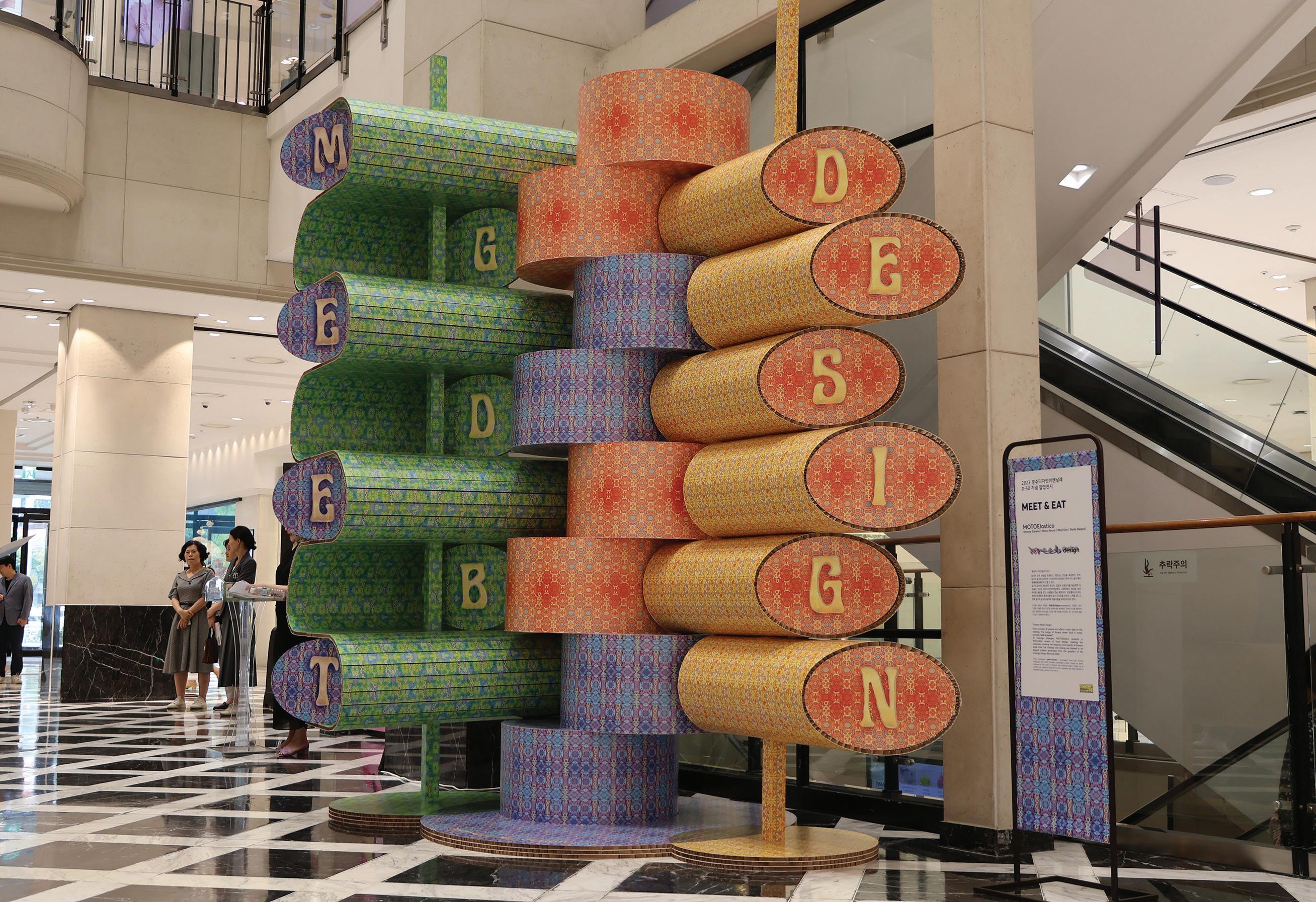
 By Isaiah Winters
By Isaiah Winters
Fed up with the two-hour drive to halfdecent beaches only to swim under the punishing gaze of killjoy lifeguards guarding me from life, I’ve retreated deep into the mountains of Gokseong County to swim in peace. In this edition of “Lost,” I’ll bring you along to two of Gokseong’s beautiful valleys terraced with swimmable pools of pure mountain spring water, each with nary a lifeguard in sight. One valley is perfect for the crowd-loving extroverts among our readership, while the other is fit for the misanthropic troglodytes among us who truly believe that three’s a crowd. So, without further ado, let’s jump in.
DORIMSA VALLEY (도림사 계곡)
This valley is hardly a closely kept secret, but I don’t think many foreigners associate the place with swimming, so this is a low but worthwhile springboard for the article. The valley is excellent to visit on weekdays and has a bevy of big enough pools to choose from almost from the start. At the lower end, where the humble restaurants and decks are, you’ll find lots of Korean families having a blast in the clear, cool waters beneath leafy boughs. Etched in the smooth rockface of the valley are numerous
verses penned by bygone scholars and monks who likely found immense inspiration beside the stream, though you’ll have to know hanja (한자, Chinese characters) to read them. Overlooked by Dorimsa, a tranquil and easily accessible temple, the broad and gently inclining valley leads up to only slightly more rugged terrain where the pools get better and better.
This is where I headed on my most recent visit, hoping to hike high enough to where I’d get a more private pool all my own. Even though it was a Tuesday afternoon, I was surprised by how many visitors lurked behind nearly every twist and turn of the valley trail. Nevertheless, it didn’t take long before I found a worthwhile pool for myself. I spent about an hour there filming, floating, and warming up on the nearby rocks whenever the water chilled me to the bone. I stayed until a pair of young guys stumbled upon the pool and shouted, “This one’s really good!” before noisily wading in right beside me. I took this as my cue to slowly pack up and leave them to it. There were other, far wilder pools still ahead, so there was no reason to stay put and exchange awkward glances with each other

here. (Pictured is one of the more rugged spots where I ended up later that day.)

Know before you go: To enjoy the best parts of Dorimsa Valley, adults will have to pay 3,000 won each for admission. If you have a car, you can drive quite far up the valley and park, but the lower end has more ample parking. In terms of cleanliness, it’s great overall, but the sheer mass of visitors means there’s inevitably going to be some trash here and there. On a related note, remember that the further downstream you swim, the more urine, spit, and snot you’ll be sousing yourself in, so head high. Lastly, if you go on weekends with hot weather, remember that I warned you not to.
Have the extroverts all gone to Dorimsa Valley? Good! It’s a lot quieter already.
Now we can talk about a more relaxing valley just a few minutes away where crowd-averse introverts can wash away their social anxieties in a lonely pool all their own. Now, I should admit up front that this section of the article is a bit of tease, as I won’t mention this valley’s name outright, but it’s easy enough to find if you consult a map. Like me, I presume you’re a nerdy loner with few if any engagements, so I trust you’ll have time to invest in the hunt. When you finally do find it, please do me one favor. If you visit on a hot weekend, go to Dorimsa Valley first and drive around the
horribly crowded parking lot. Your stress levels will rise as you slow to a crawl between the narrow traffic lanes lined tightly with vehicles parked in the most imaginative ways. During your misery lap, if you see another driver snag a coveted parking space, roll down your window and shout “좋겠다!” (“Must be nice!”) to let them think they’re winning the game of life. Then, when your trolling quota has been met, simply do a U-turn and head over to [Redacted] Valley.
In just a few minutes, you’ll find plenty of parking and enjoy the luxury of opening your car door fully to get out – not halfway to where your clothes swipe your car door clean as you shimmy your way free. You’ll pay nothing to enter, and after a ten-minute stroll, you’ll be greeted by the sights and sounds of several valley pools that will look almost as lonely as you. You may see a few people here and there, but just keep your calm and walk a bit more up the valley to another spot. On our first visit, the missus and I spotted a perfectly wide and deep pool, but a family was putting it to good use, so we left them to it and soon found an entire waterfall all our own to relax at. Once thoroughly chilled by our private cascade, we warmed up again by hiking a bit further into
the valley to a rolling double waterfall, where we were secluded enough to pull out our Bluetooth speaker and enjoy leftover Alleyway pizza to Elvis Presley’s “Peace in the Valley” as the sun dimmed to a flicker behind the falls. If you eventually find this location, going from the pressure cooker of the Dorimsa Valley parking lot to this little slice of valley nirvana in such a short time will be immensely satisfying – trust me.
Know before you go: The valley is quite long, but you won’t need to go far to find great pools. If you’re adventurous and want to explore

If you eventually find this location, going from the pressure cooker of the Dorimsa Valley parking lot to this little slice of valley nirvana in such a short time will be immensely satisfying – trust me.“Peace in the Valley” as the sun sets behind a rolling double waterfall.
further up the valley, go ahead. However, I’ve ventured quite far up and can attest that the rolling double waterfall is the last great pool to swim in. Pools above this point are still beautiful and deep enough for a dip, but they’re less impressive. If you make your way up further still, you’ll find the source of the valley stream: a spurt of water gushing from under a huge pile of mossy boulders. Climb these boulders and you’ll find it mostly dry and sandy up top, making the contrast surreal. On a final note, don’t be surprised if the little minnows in this valley gently nip at your legs while you swim. They’re just trying to see if you’re edible.
Are the introverts gone, too? Thank God! The neurotic bunch.
Now that it’s just the two of us, I’ll vaguely tell you about a third valley – we’ll just call it “Secret Valley #3” – that blows the previous two to bits for its cleanliness, seclusion, and serenity. I spent an entire week in mid-August going way off the beaten path to find something special for this article, and the valley I ended up at was so
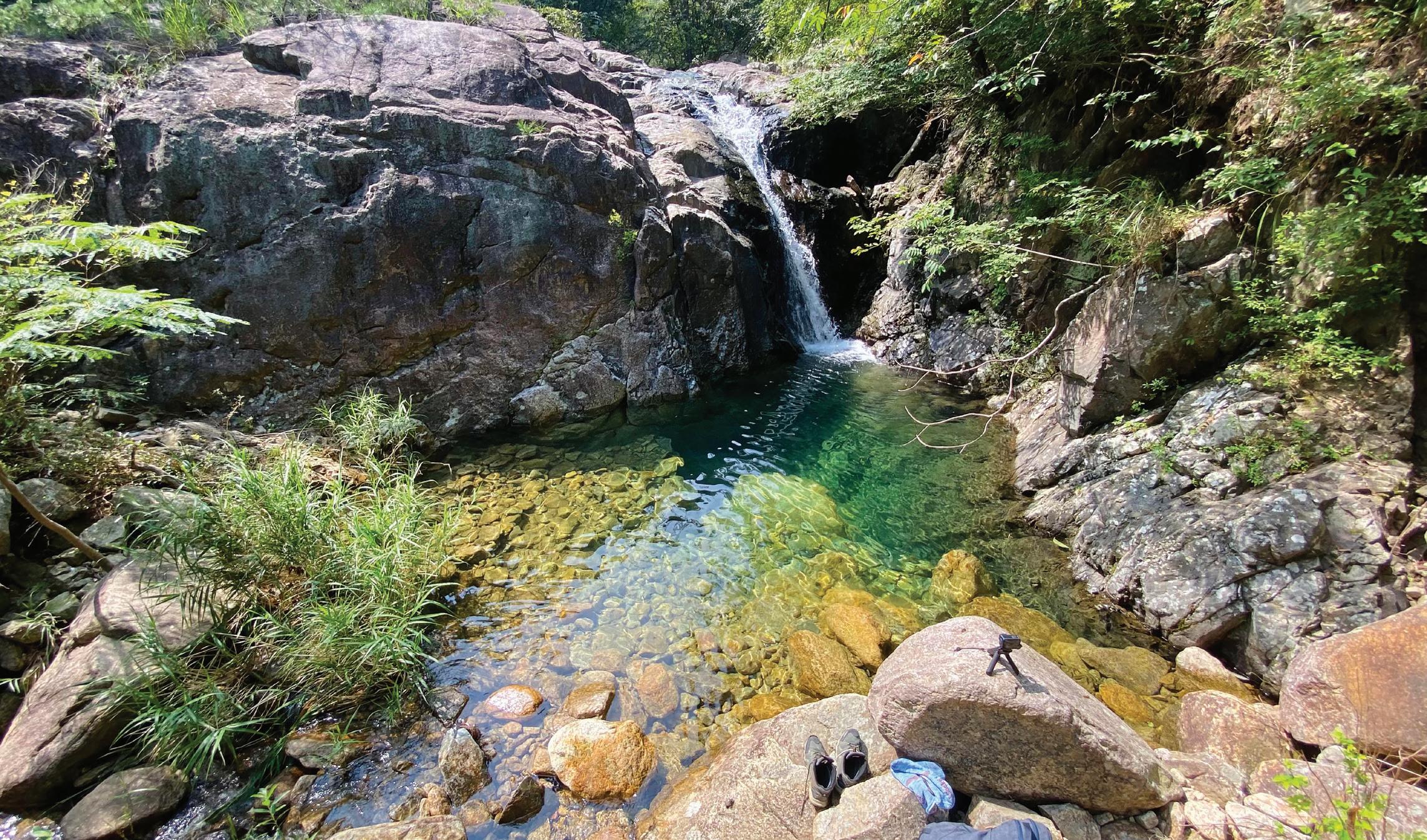
good that I almost felt guilty enjoying it alone. Its best bend had a comfortingly shallow pool that abruptly ended at an underwater precipice – the depths beyond which I only reached after jumping off the nearby rocks and allowing myself to sink as low as possible. Best of all, this pool’s got a steady waterfall to provide an original soundtrack to the experience. If you ever manage to find it, I recommend holding your breath underwater and listening to its muffled majesty for as long as you can while you ponder the fact that if some accident were to befall you here, nobody would likely ever find you. Oh, second best of all, the fish here seem to be so unfamiliar with people that they’re too timid to bite, though that might change if said accident were to occur, rendering you a perfectly viable food source. On that awkward note, happy hunting!
The AuthorHailing from Chino, California, Isaiah Winters is a pixel-stained wretch who loves writing about Gwangju and Honam, warts and all. He’s grateful to have written for the Gwangju News all these years. More of his unique finds can be seen on Instagram @d.p.r.kwangju and YouTube at Lost in Honam.

Let’s imagine a foreign friend asked about the Korean word baram. Besides meaning “wind” in Korean, baram has various other meanings. How should we explain this word?
Baram (바람, “wind”), a refreshing airflow Baram (바람, “hope”), an eager wish Baram (바람, “movement”), the vitality of new beginnings

Or there may be people who think of the famous Korean song lyrics “Your name is wind, wind, wind (그대 이름은 바람, 바람, 바람).” As such, baram is one of the most beloved words by Koreans, and art inspired by this word has constantly emerged across generations.
In Gwangju’s Dongmyeong-dong, there is a place that successfully embodies the three meanings of baram. As you stroll through the winding alleys of Dongmyeong-dong, you might chance upon a captivating gallery that invites you to linger. Within its walls, you could awaken the slumbering artist within you. I was fortunate to be able to interview the proprietor of this place that embodies the three baram.
Gwangju News (GN): Hello and thank you very much for accepting this interview offer. Can you briefly introduce yourself and this gallery Nice Windy Day?
Kim Wang-ju: Hello, I am Kim Wang-ju, a full-time fine artist currently based in Gwangju. I graduated from the Chosun University College of Fine Arts, where I majored in Western painting. In the past, I focused on installation art and abstract painting, and now my work centers around expressing myself using various colors, with a special focus on Obangsaek (오방색, “five colors”) – the five colors used in Korean traditional art. My representative works include Dress Table (화장대), Nidāna (인연, “Relationship”), and Nice Windy Day (바람불어 좋은 날).
I am running the Nice Windy Day gallery with the support of Gangdong Group, a local company the Jeolla area. The Gangdong Cultural Foundation created this gallery with the hope that Gwangju citizens can visit it as comfortably as a playground. I also aspire for many people to freely visit the Nice Windy Day gallery and enjoy art and culture.
GN: It is amazing that there is such a lovely gallery in the middle of Dongmyeong-dong, which is renowned for its cafes and restaurants. Could you tell me more about this place?
Kim Wang-ju: This building was originally a Western-style house built in 1978 and was renovated the year before last by Gangdong Group. As a result, the original appearance of the house has
been preserved in every corner, creating a unique and cozy atmosphere that distinguishes it from typical galleries.
Additionally, the gallery was designed with a focus on the exhibition hall from the beginning of the remodeling process, resulting in well-equipped facilities such as exhibition spaces and storage. Personally, I hope that the Nice Windy Day gallery will stand out even more because of my works, and that my works will shine more because of this place.
GN: What led you to open certain areas of the gallery for Gwangju citizens to play the piano, relax, and spend time?
Kim Wang-ju: Gwangju, once known as Yehyang (예향, 藝鄕, “City of Art”), has a long history of producing numerous artists and art enthusiasts. However, I noticed that crossing the threshold into art exhibition halls remained a challenge for some Gwangju citizens. I have witnessed many people hesitating in front of the gallery doors and eventually turning back due to the psychological distance they feel about the exhibit hall, even though it is intended for the enjoyment of many people.
As a result, Nice Windy Day aims to be an art gallery with a low threshold. I hope visitors perceive the gallery as a playground, where they can experience my paintings like a beautiful sunset sky or a cloud-like landscape. My aspiration is for this gallery to be a place where people can comfortably enjoy art and harmony. As an artist in “Yehyang Gwangju,” I hope that many people will freely visit the Nice Windy Day gallery and indulge in art and culture.
GN: The purpose of the gallery perfectly aligns with its name, Nice Windy Day. I am curious about what inspired you to choose this name for the gallery.
Kim Wang-ju: Originally, the gallery was named Wind, Wind, Wind (바람, 바람, 바람). I believe that “wind” holds three significant meanings: the natural wind, the wind meaning hope, and the various winds that blow in life. In life, there are stormy winds that challenge me, as well as gentle breezes that invigorate me. I believe that no matter what kind of wind blows into my life, it is still a good life and a good day. Therefore, I finally decided on
the gallery name Nice Windy Day. Additionally, the word “wind” was frequently used in the titles of my paintings.
GN: What are the three baram (바람, “hopes”) you hold as an artist while operating the gallery?
Kim Wang-ju: The first hope is for my artworks to be more widely known through this gallery, and for this place to be more beloved because of my works. My second hope is that the citizens perceive this gallery as a comfortable and welcoming place to visit.
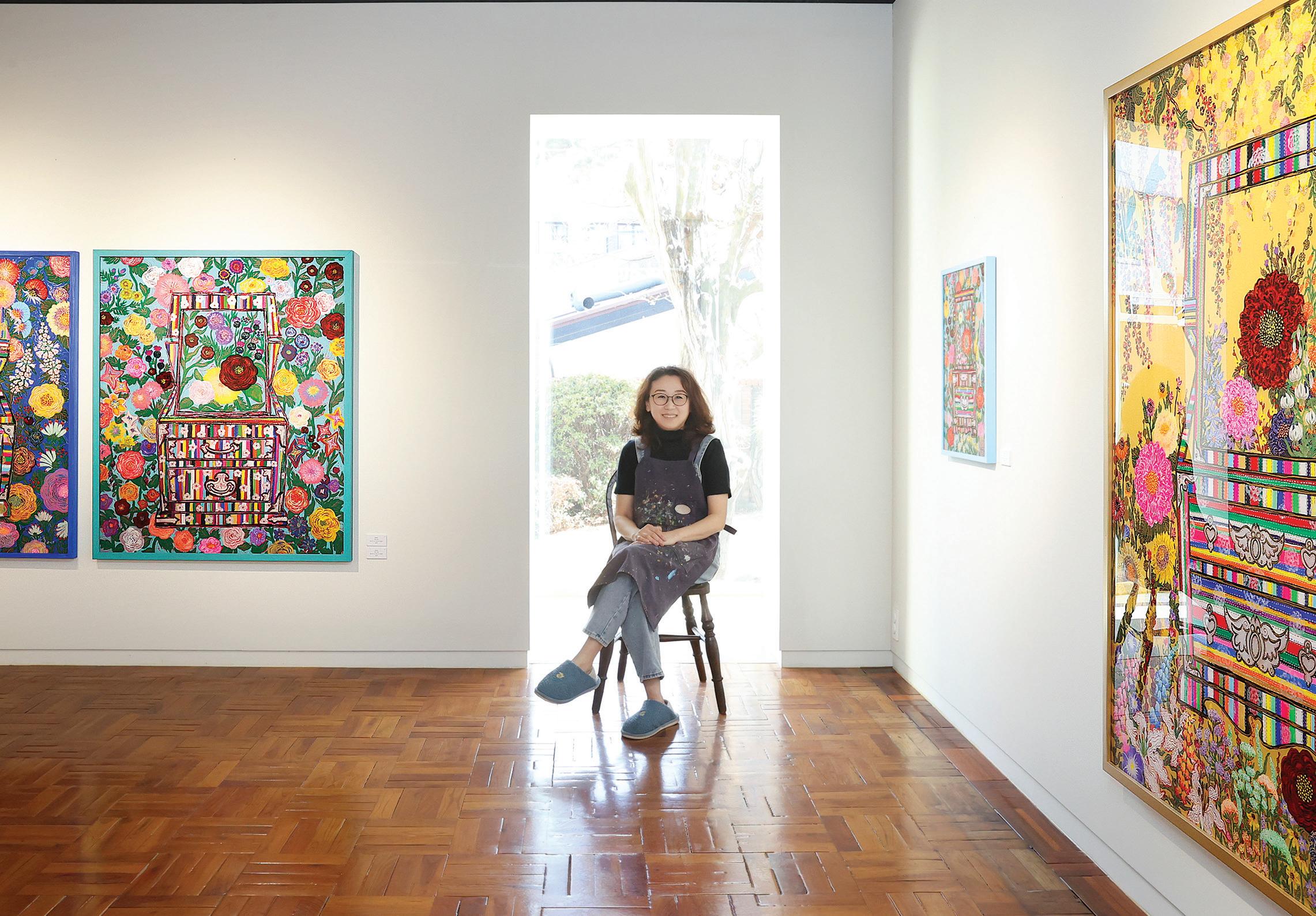
Lastly, I hope that the Nice Windy Day gallery becomes a source of pride for the citizens of “Yehyang Gwangju.” This place is open for everyone to enjoy and communicate through art. Just as the wind serves as a source of circulation, harmony, and connection in nature, I aspire for this gallery to play a similar role in Gwangju, a city that cherishes art. Therefore, my aim is to create an environment where art and citizens coexist harmoniously in one gallery.
GN: Thank you for taking the time to do this interview and we wish you the best in your endeavors!
The Author
Koo Yesol is from Gwangju, South Korea. She has been interning at the GIC and is responsible for providing translation support and writing for the Gwangju News and the GIC Newsletter. She majored in Korean language and literature and has diverse experiences in writing. She also actively participates in foreign-related groups in Gwangju.

Just as the wind serves as a source of circulation, harmony, and connection in nature, I aspire for this gallery to play a similar role in Gwangju, a city that cherishes art.
These three are the best doctors by far, as per popular wisdom. They dole out the very best fitness prescriptions for us all. The counsel epitomized here seems to be a useful lodestar for all seekers of optimal wellness. At the very least, this three-pronged regimen merits a careful and thorough analysis. In the remainder of the current article, we shall thus be looking into those three prongs in some detail one after another.
Of the three doctors, the first calls for sensible eating. A sensible diet must needs be diverse and inclusive with the proviso that it should strike a balance between its component elements. While keeping away from picky eating, sensible dieters must see to it that they keep at arm’s length certain things such as red meat. In fact, sensible food consumers would center their meals around vegetables, fruits, seafood, and poultry. What is more, it would be ideal should they decide to turn to such food resources as are available locally and seasonally.
Giving a wide berth to food tampered in any way should also be part and parcel of all sensible dishes. GMOs would thus normally be a nono, as would any chemically tainted stuff. Most artificial nutrition supplements would not generally be acceptable to most conscientious food consumers, either. Health-conscious dieters must take in food in moderation only also, paying constant heed to the red flag being raised by “Much meat, much malady” and “Greedy eaters dig their graves with their teeth.”
Let us conclude our discussion of Dr. Diet here with due homage paid to the popular saying, “Kitchen physic is the best physic.” Homegrown and home-cooked, kitchen physic barely touches anything artificial, with the result that it is close to 100 percent in its natural state. Absent any trace of tampering, it may very well be the choicest option for the family table, which should always brim over with hearth and home. So much for Dr. Diet.
Now, what does Dr. Quiet prescribe for all of us health buffs? We are called upon to retreat into the deepest nooks of our inner selves and seek sanctuary in the land of absolute calm and quiet, where true peace of mind dwells. The road to this land of heavenly peace is paved with perfect rest and relaxation. Breaks of all sorts can come to our assistance on this front. Leaves, R&Rs, vacations, and recesses can rise to the occasion here. So can camping, trekking, scouting, and all other ways of inviting Mother Nature into our hearts, minds, and souls.
BTW, meditation may be the high road to true inner serenity. Deep thinking via yoga, for one, is thought to be a surefire path to the land of Dr. Quiet. Yoga is believed to make its practitioners one with the universe, detaching them from the day-to-day anxieties of this world. Zen may be equally effective in lulling us into this realm of perfect calm and quiet.
With the world today literally inundated with digital devices of all kinds everywhere, too much screen time is increasingly becoming an urgent
health issue all over the globe. Fact is, many of us are practically glued to the screen day and night, often in closed and cramped quarters. Sometimes dubbed digital addiction, this crazy phenomenon has already been raging like a wildfire for over a couple of decades now.
The way out of this mess can perhaps be found in breaks and retreats at out-of-the-way locations safely tucked away from the rough and tumble of this dog-eat-dog world. This can hopefully deliver our burned-out nerves from their ruthless digital masters.

Dr. Merryman is our third and final honoree of the day. Dancing attendance on Dr. Merryman is his guardian angel, ever ready to do his every bidding and deliver his health potion, as needed. This guardian angel of Dr. Merryman’s has at his fingertips such beautiful things as dance, music, art, theater and cinema, and literature. They are all well known for their miraculous hold on the human heart, mind, and soul. They can wield their magic wands to bend our thoughts at will.
Well within Dr. Merryman’s province, beautiful scenery, for one, is thought to be right up there with state-of-the-art medical treatments. It is believed to be a good cure especially when it comes to addressing seemingly incurable conditions. When feeling off-kilter, we are often counseled to turn to beautiful things in our surroundings. Clear brooks, green mountains, flocks of birds on the wing, or flowers about to bloom are all very pleasing to look at, not for no reason, mind you. So too are mere sunsets and sunrises. As is the
bright moon or the starry night rendering our otherwise dark evenings as charming as could be. Any way you slice it, beauty gives rise to joy, which in turn sows the seeds of laughter. And laughter is the best medicine, the Gospel truth of which is enshrined in the collective wisdom of all humankind.
By way of closing, let us note that our three best doctors often work hand in hand, rather than all by themselves. Dr. Diet, for one, brings peace of mind and joy of heart as well, not just nutrition for the body. Now then, shall we all try and keep well by constantly drawing from these three wells of wellness?
Long live Dr. Diet, Dr. Quiet, and Dr. Merryman! And may each and every one of you stay fit and healthy! When everyone takes care of himself, care is taken of all. Right? I wish you all a long and happy journey aboard spaceship earth! To my mind, the Gwangju International Center has certainly earned pride of place on this beautiful spaceship. That is what I firmly I believe.
Park Nahm-sheik has a BA in English from Chonnam National University, an MA in linguistics from the University of Hawaii at Manoa, U.S.A., and a PhD in applied linguistics from Georgetown University. He is now a Professor Emeritus after a long and illustrious career at Seoul National University as well as President Emeritus of the International Graduate School of English.
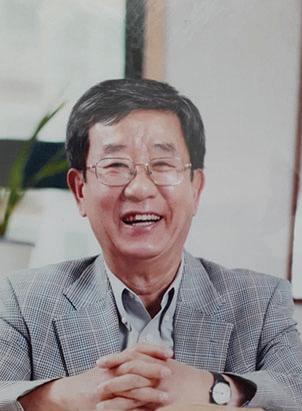
As a young man in Canada, nothing was more riveting, nothing was more important than the first season of the TV show Survivor. It was a cultural phenomenon, uniting people around the globe in their desire to see who would emerge victorious after the final tribal council. One of the fondest memories of my youth was huddling around the television with about ten other people one summer evening to watch Richard Hatch claim the million-dollar grand prize.
That first season of Survivor took place in Borneo, and I knew it was a place that, sooner or later, I would have to visit. This past summer,
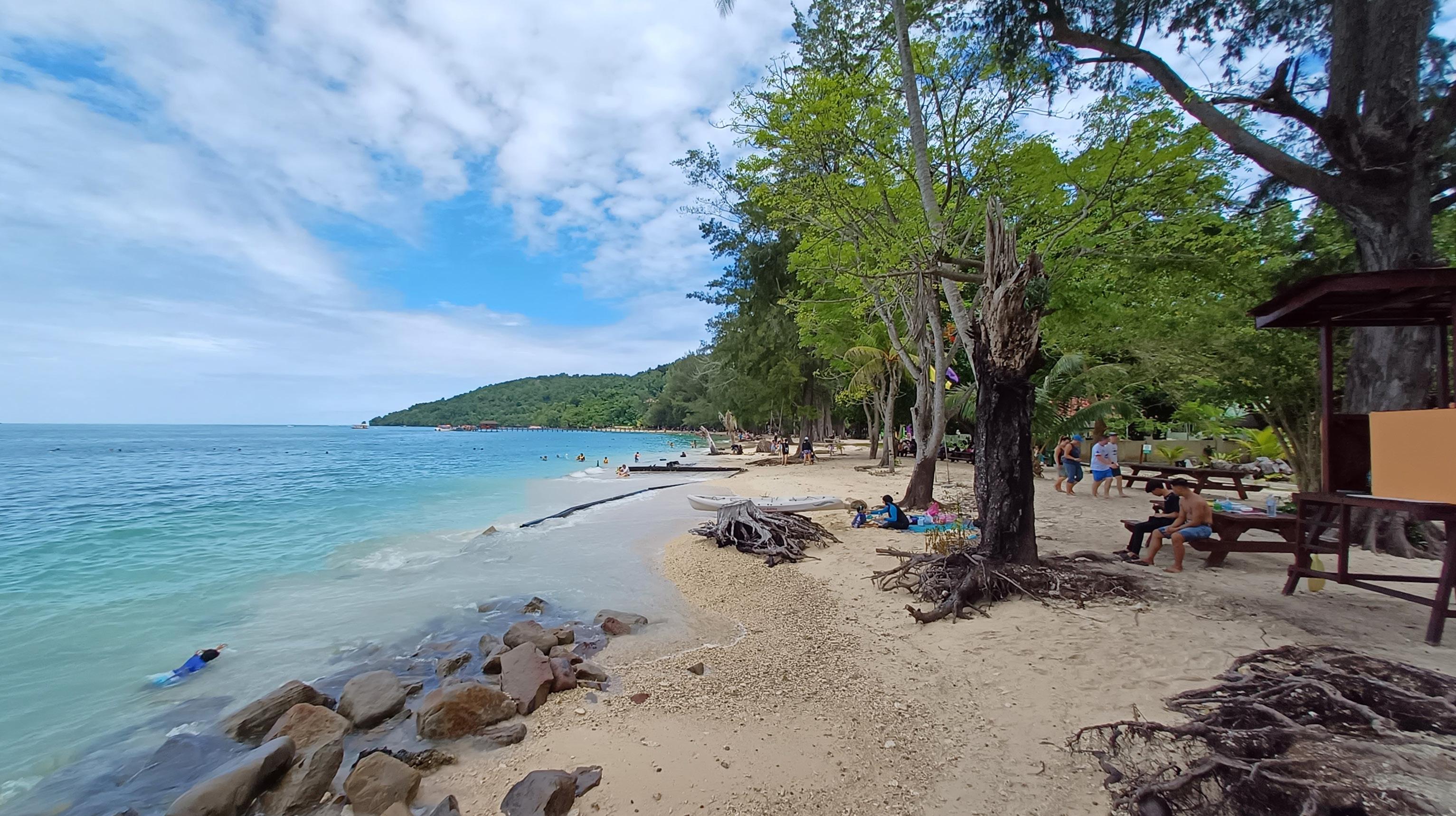
that dream came true, and unlike the later seasons of Survivor, Borneo did not disappoint.
Kota Kinabalu (or simply “KK”) is a city of about half a million people located in the northwest of the massive island of Borneo. Borneo itself is actually divided into three countries: Malaysia, Indonesia, and the tiny nation of Brunei, with the Malaysian part occupying roughly the northernmost twenty percent of the island.
Of course, it is possible to travel to KK via Incheon, but for this trip, my wife and I decided to test our luck with the Gimhae Airport (just outside of Busan), since we have grown tired
of the unabashed rigamarole of the U-Square airport bus. Taking the car to Gimhae Airport worked well enough, but it was a pretty hard three-hour drive. On top of that, unlike at Muan Airport, parking is not free, so keep that in mind. While taking the car to the airport offers the advantages of, well, taking the car to the airport, I would not go so far as to say it was less stressful than bussing it to Incheon.
After the five-hour flight to KK, the first thing you will want to do after clearing customs is to get a SIM card with a phone number. There are several stores on the arrival floor that sell SIM cards for a very reasonable price. I got a card for 35 ringgit (about 10,000 won) from a company called “Digi” which gave me unlimited calling and a completely ridiculous 30 GB of data. Who would use that much data on a week-long holiday is beyond me, but whatever.
The reason it is essential to get a SIM card with a phone number is that it is needed to sign up for the incredibly convenient and intuitive Grab app. Grab is basically the Uber
of Southeast Asia and, in fact, a few years ago, Grab bought out Uber in the region. Another way to think of Grab is that it is the super-app Elon Musk wishes his newfangled and newly rebranded “X” app could be.
Basically, nobody uses taxis in KK, and with how easy, fast, cheap, and all-around amazing Grab is, it is easy to see why. It takes less than five minutes to download and set up the app, then, in terms of getting around, you have it made in the shade.
I do not want to get off topic here, but in my opinion, Korea would be better off with Grab, and it is a shame that so far e-hailing services like it and Uber have been blocked. A story for another day, I suppose.
On a final note, while I am fundamentally opposed to tipping, I would say it is a good idea to go right ahead and throw your Grab driver an extra couple of ringgit at the end of every ride. It is a couple cents to you, but the drivers really appreciate it, especially when a ride across town only costs two or three bucks.
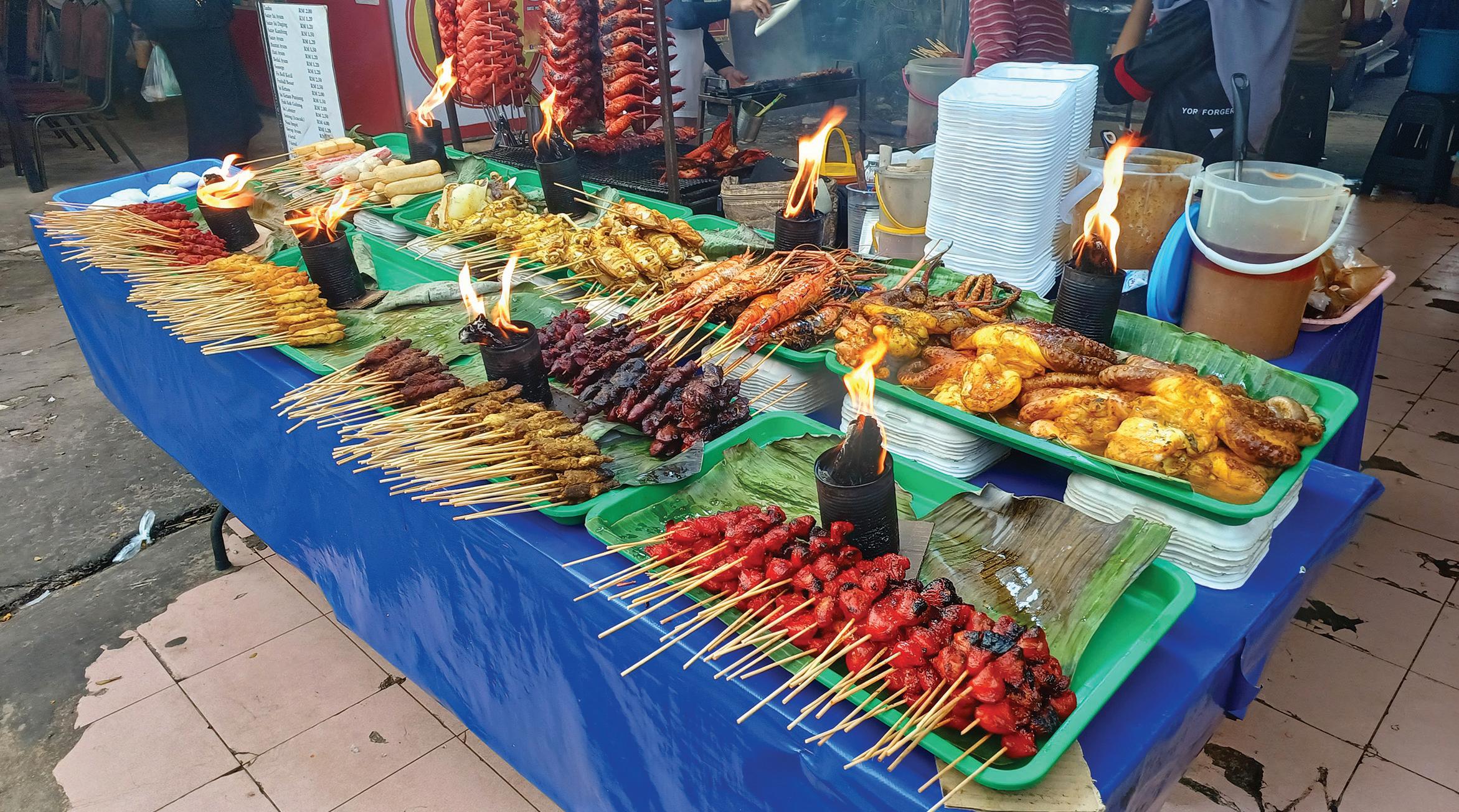
There is so much to see and do around KK, but since we had the good fortune to arrive early Sunday morning, checking out the Gaya Street Sunday Market worked out great. From 6:00 a.m. until 1:00 p.m., Gaya Street gets blocked off so that vendors can set up booths and sell all sorts of clothes, food, and crafts. The atmosphere was lively, music was playing, and best of all, there was a great ice cream truck. This market is right downtown and close to the waterfront, so spending a few hours there is definitely worth it.
Malaysia is predominantly a Muslim country, so it is no surprise that KK has a couple of absolutely phenomenal mosques. We first visited the Blue Mosque, which is surrounded by a moat, giving it the moniker “the floating mosque.” When the moat fills up during the rainy season, it creates the illusion of the edifice sitting right on the water. We arrived a bit late (the mosque closes to visitors at 5:00 p.m.) and were not allowed to enter onto the grounds but were still able to get a great view from the road.
The Pink Mosque, officially known as the University Malaysia Sabah Mosque, was even more brilliant in my opinion. The color and surroundings made it a great place to take copious selfies or just enjoy the atmosphere. A word of warning though: If you are staying downtown and take a Grab to visit the Pink Mosque, make sure you stay off the road around 9:00 a.m. and 4:00 p.m. The university campus is a few kilometers north of the city center, and traffic during rush hours is absolutely bonkers. You have been warned.

There are modest admission fees for each of these mosques, and also keep in mind that if you are interested in actually entering the buildings, you must be wearing appropriate clothing (which appeared to be available to rent).
To visit KK without spending some time on the islands just off shore would be a total and complete shame. While there are countless tour companies offering “all in” tours, it is easy enough to head over to Jesselton Point Ferry
Terminal and make your own arrangements. Boats for the islands leave frequently in the morning, but I would really suggest getting there before 8:00 a.m. because the terminal is one of the most hectic and chaotic places I have been in years. As well, whatever you do, do not buy a ticket from Titong, which is by far the worst-managed boat company in the history of maritime navigation.
Anyway, as long as you did not buy a ticket from Titong, eventually you will get on a boat and be whisked away to island paradise for the day. We visited the islands of Sapi and Manukan for one day each. Sapi was beautiful, but Manukan was the absolutely stunning, beautiful, jawdropping, idyllic beach fantasy from my dreams – every bit as good as my younger self had hoped when watching Survivor in the year 2000.
Boats leave the island every hour on the hour, and while looking for your boat, you can expect the same confusion and jostling that has made Jesselton Point Ferry Terminal the subject of recurring nightmares worldwide.

Things in KK generally do not cost that much, so if at all possible, try to get some smaller bills. For example, trying to break a 100-ringgit bill (about 30,000 won) on a couple of mango juices will probably be difficult for the vendor.
Most of the Grab drivers and locals (especially vendors) speak excellent English, but it was also a pleasant surprise to find out how many people knew a few phrases in Korean! This is of course due to the millions of Koreans who visit KK every year.
Even if you are one of the seven or eight people on earth who have no interest in Survivor, KK is still a great place to visit and a gateway to the rest of Borneo. Just remember to bring lots of sunscreen.
William Urbanski tries to visit a new country every year. When he is not working for the Gwangju News, he can be found at home watching clips of Survivor on YouTube.


Julywas the hottest month on record. For several decades now, we have emitted greenhouse gases far beyond sustainable levels. Maybe the attention is finally where it should have been in 1989. Unfortunately, the discourse is almost always dissonant or counter-productive, and it feels difficult for any one of us to do much of anything. We cannot change global policies, and our localities seem inconsequential. We become misanthropic. We feel powerless. We turn to wizards to save us. However, the fault lies not in our stars, but in the logic of the world system, and there are more things in Earth right now than are dreamt of in some tech bro’s philosophy.
Fighting global warming in a world without a single global government is prone to the prisoner’s dilemma, which states that we are all better off with solidarity, but the incentives are such that every individual benefits by defecting. “My cheating alone won’t sabotage the project.” Taken alone, it is not wrong. Now imagine everyone thinking that.
Unsurprisingly, finger-pointing and appeals to do nothing abound. “What if we stop burning so much coal, and it was all for nothing?” Is preserving human civilization the only justification for cleaner air? What if we curb our emissions while others keep polluting? Cheaters would benefit as they take cheap shortcuts and “free-ride” on the rest of us being conscientious. This is true, but we should not assume we will be powerless to deter cheating, the gains of cheating are immense, or the survival of our civilization is not worth the effort if others can also reap the benefits.
The crux of “international relations realism” is to ensure one’s own survival by wanting to have every potential rival relatively worse off. However, having every country including your own collapse from famine, droughts, and floods is the pinnacle of irrationality.
Is any country doing it right? East Timor’s CO2 output is quite low, but look at Southeast Asia as a whole, and the CO2 needed to get a mediocre standard of living is not encouraging. Europe? Not if you consider the consumption of goods that were produced in Asia. Australia? Per capita output seems low, but Australia cannot wash its hands when others burn the coal it exports. China? It is the biggest producer of green energy in the world, but it exploits its “developing nation” status to over-fish all over the world. Quantifying national guilt is not simple.
What of technological improvements? Beware the blind faith that magical solutions do exist and also that we will discover them in the vague “near future.” Forget the scams. We have long had great solutions. The electric subway is from the 1890s! Even a diesel bus system is stupendous for the environment if it means fewer people buying, driving, parking, and charging personal cars. Bearing in mind that construction costs correlate with CO2 output, the infrastructure costs for sprawl are staggering: the ten-lane highways, the paving of parking lots, the electrification and plumbing of distant buildings, etc. When considering maintenance, remember that road damage is axle-weight to the fourth power times speed. Now consider that an e-bike is a fraction of the weight of one car and uses one tenth of the lithium. The inescapable fact is that inefficient consumption of resources needs to stop, not that we simply switch from buying gasoline cars to electric cars.
Personal freedom is great, but is consumption writ large actually good or even personal? If the freedom to swing your fists stops at my face, then what a gargantuan crime it is for the biggest consumers to inflict global warming on those least able to survive the fallout.
Only two things will stave off the worst-case global warming: efficient consumption and the intelligent planning of towns. These decisions are inherently social, and ideally should be democratic, but they must be collective. We are all in the same boat.

What are we to do as denizens of Gwangju? Let us re-examine our lifestyles and the infrastructure that guides our lifestyles. Person A rides the subway or the bus for most errands. She gets most of her groceries from the market down the street. She tells her kids to go play outside when they clamor for a larger house. Her life is getting harder, however. She can hardly wheel her groceries around when the sidewalk is in shambles. Person B drives his personal BMW to the Starbucks drive-through for his daily fix of imported coffee beans and sugar. Running by the Gwangju Stream would be nice, but there is nowhere to park his car once he gets there, and he wants to drive there. Instead, he goes to the gym with treadmills and free parking.
We should ask which person’s lifestyle our city is encouraging because the world around us conditions our choices. Building more highways and letting sidewalks fall apart encourages excessive driving and discourages walking. Let’s build towns using a rubric of environmental sustainability, quality of life for everyone, and financial solvency. To get the last bit out of the way, public spending is never a luxury when you consider the financial costs of maintenance. Most of the costs related to sprawl are in upkeep. When we turn to quality of life, we see that we can kill three birds with one stone. Greener cities are also cheaper and yield a higher quality of life for everyone. Transit helps children, the elderly, and others to be independent. Do you want every blind or paraplegic person to sit inside trapped all day? Just cut to the chase and tell them and their families to leave. Or, stop building highways and demanding more births. Make a place where all people want to live and can live – sustainably. All the promises of carbon neutrality by “Year X” are empty without any functioning model of a greener city – and we will all live happier lives as a bonus.
The AuthorJonathan J. Chiarella grew up in New York. He holds a BA in history (Rochester) as well as two MAs (Chonnam, Florida) and a PhD in politics (Florida). You can spot him riding the river trails or read his analysis of current affairs related to Honam or international relations.

Only two things will stave off the worst-case global warming: efficient consumption and the intelligent planning of towns.Starbucks drive-through. (Photo by Tfurban on Flickr)
 By Stephen Kagarise
By Stephen Kagarise
To think what might have been is the bitterest regret. Yesterday I walked past this island at low tide. A rocky path extended out through waters parted, smooth like cobble, as inviting as a smile. If only
I had walked that hip’s graceful curve and climbed that peak of lush green paisley, with blonde tints from the sun. What a life I would have made there, an eternal yoga pose in that land of rugged affection. Today is high tide. The path has sunk. Waves of longing crash where my feet should have trod.
 Photo by Yeonhee on Unsplash
The Author Stephen Kagarise is from North Carolina and has been living in Gwangju since 2012. He is the author of a short book of surrealist poetry called Hysterion
Photo by Yeonhee on Unsplash
The Author Stephen Kagarise is from North Carolina and has been living in Gwangju since 2012. He is the author of a short book of surrealist poetry called Hysterion
This is a reality that many foreigners face. While I desire to stay another year, I know many of my English teacher friends will leave Korea after one year. Others I have met, like international students or career teachers, plan to be here much longer than I have so far. Each time we meet, I know our paths have crossed for this brief amount of time in Korea. Then, whether or not I am the initiator or the receiver of this break up, our journeys will split... Probably forever. Knowing that these relationships are temporary makes me want to grip onto the sand until my hands bleed and it slips through my fingers.
From the moment my plane landed at Incheon International Airport in snowy January, I knew the clock started ticking.
As a native English teacher bound by her contract, I knew that one year was all that I was guaranteed. Whether or not I could renew for another year – whether or not I would remain in the city of Gwangju – was up in the air.
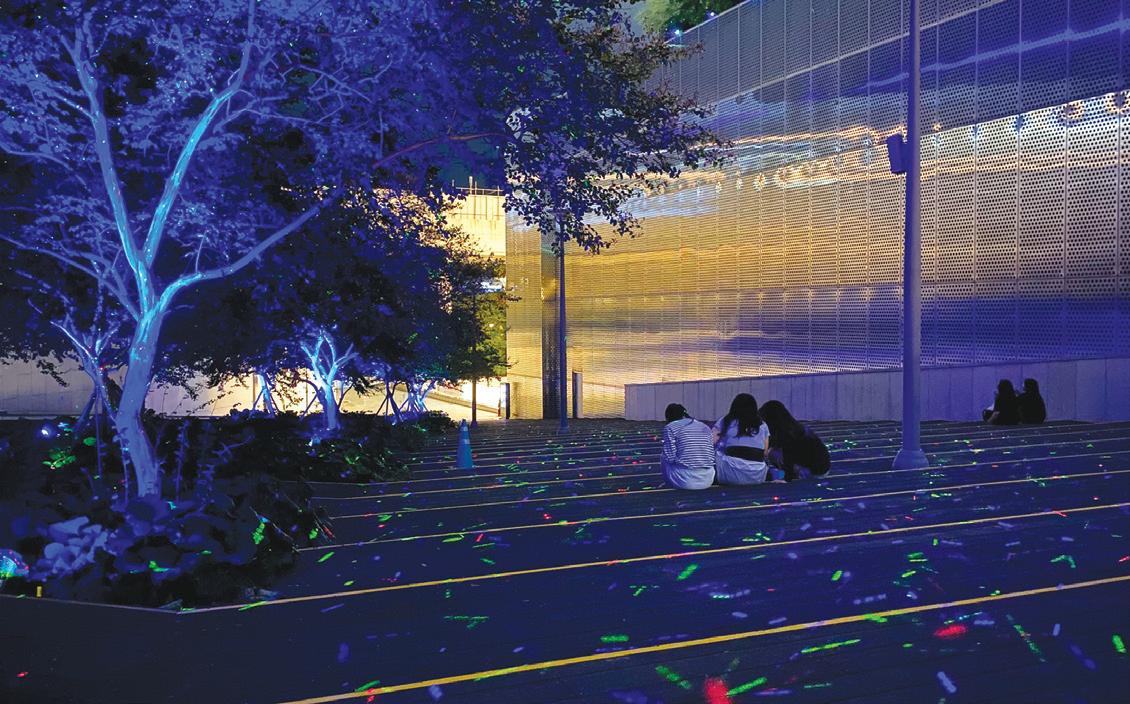
It feels as if a timer is floating above my head, and I am helpless watching the numbers count down. Time has ticked by so fast; it is almost as if someone spammed the fast forward button on a remote. I have less than four months left of my contract, less than four months left of certainty. Any second, the play button will resume reality as I get yanked away from the life and community I worked so hard to build for myself.
And that makes me terrified.
Sindi Dhlamini arrived a few months after me, in May, and I met her within her first few days in Gwangju. Three months later, I reached out to Dhlamini to see how she views friendship and community building this early in her journey. While she has not really thought about the temporality of friendships, she said the experience of being abroad has given her new insight.
“It’s almost like we’re dating each other, in this friendship that we’re building,” Dhlamini said. “We’re learning how to build friendships, and we have to try and meet people halfway. You realize that we’re so different, yet so similar at the same time.”
To Dhlamini, it has been difficult to form genuine connections with people. While one of the beauties of the foreigner community is crossing paths with people one might not have otherwise, there are also instances where relationships feel as if they are formed simply because two people are foreign and looking
for friends. When I asked Dhlamini if she ever feels lonely, she said there were times where she misses home.
“I feel like I haven’t fully been able to be vulnerable with people yet,” Dhlamini said. “To some extent, loneliness really, really hits.”
I have been fortunate to have found a community in a weekly language exchange in Gwangju. The organizer, Kim Hyun-woo, first launched the exchange early in the year, and it has seen a steady growth in participants. Kim has been a Gwangju resident his entire life, and he started these meetings to provide a safe space for people to share their culture and ways of thinking.
To me, Kim feels like a fixed point in a community that is constantly morphing. As a Gwangju native, he will always remain. Kim told me one of the reasons he formed the language exchange was because he loves meeting new people and understanding things from their point of view. Yet, with these connections he is forming, more likely than not, these people will leave within a few years. Does it not hurt?
“I will feel sad,” Kim told me. “But I have always known that this kind of relationship I will make – this community – will be really temporary… I have already prepared myself for it.”
Like Kim, I know that goodbyes are inevitable. And I too have prepared myself for it.
After living in Korea for a total of 13 years, Ronald Harford, co-founder of Loft 28, has become well versed in saying goodbye. With his experience as both an expatriate and a co-founder of a popular gathering spot for foreigners, Harford has seen multiple facets of the foreigner community. During our conversation, Harford acknowledged the feeling of sadness is definitely present every time he says goodbye to people, especially with those that he formed a close bond with. While he has slowly become accustomed to it, he told me it is “never easy.”
Harford reflected on his past customers who, when returning to Korea on vacation, would visit Loft 28. Sometimes these returnees would bring new friends or family members, and to Harford, it holds great value that Loft 28 was able to become such a meaningful space for these people. Even though people are constantly cycling in and out of the community, Harford has made strong connections that still live on, even as distance separates them physically. “The friendship continues wherever we may go,” Harford told me.
Especially for those who do not plan to be in Korea long-term, I think most of us are aware of the ticking time that passes us every day. Our existence in this space is temporary, and that is simply a fact that we live with. We know that one day we will leave this place we currently call “home,” and oceans will come between us and the community we had built. It is sad. And it is lonely.
However, because of that, my experience in Korea has placed greater emphasis on focusing on the now. Each moment, each memory, each friendship is so precious. I love meeting my friends for American-style brunch at Sabotage and sipping a milk tea float at a local cafe. I love going on spontaneous day-trips to nearby cities like Naju and Damyang, while hiding out in indoor establishments because the weather is too hot. There are so many memories that I am so grateful for, and so many more that I will make in my last few months.
Even though I know that one day my time will end, the friendships and memories I made were real.
As a writer, Francesca Duong, strongly believes in the power of narrative as a platform for truth and discussion. She loves lengthy conversations, being involved in the community, and discovering delicious foods.

well, especially in preparing my slides since they needed to be able to catch the attention of 15-year-old students. Not only that, but to make the Malaysian class the most exciting among the ten countries, we cooked traditional Malaysian snacks made of coconut and palm sugar, known as Kuih Ketayap, together with 28 students. Although it was quite a hassle, as preparing food requires lots of work, Mrs. Oh handled it well, and I could not imagine proceeding with the class without her. The class only lasted for 90 minutes, but in that short period, I learned numerous life lessons.
It is said that summer vacation is one of the best times during one’s university life. Some went on holiday, others took extra classes to earn more credits, and as for me, one of my activities during this two-month school break was teaching culture classes. It is a one-day freelance job introducing things like Malaysian culture and food to Korean middle school students. Using the class as a platform, I got the opportunity to meet with respectable foreign teachers from Japan, Australia, Syria, and many other countries. All of them had resided in Gwangju for multiple years and, throughout our classes, they shared lots of insights about the city.
Before the class was held, local and foreign teachers gathered and discussed how we should design our program. I was paired up with Mrs. Oh Mi-sook, who guided me very

1. Opportunity to explore other cultures, traditions, customs, beliefs, societies, languages, and much more (Kanakia 2020).1
South Korea is largely an ethnically homogenous country, and it is a rare opportunity to meet and sit around with people who are not Korean. Thus, having a culture class with international teachers is a golden chance for the students to get to know about other nations’ cultures and traditions. As students are exposed to world cultures, it can also be a spark for them to study abroad and explore more around the globe.
2. Bringing unity among diversity (Naik 2020).2 Prof. Niraj Naik mentioned that international education gathers together participants who can make discoveries together, and that there is a multitude of similarities that exist between us all. Exchanging cultures allows us to understand that we are merely trying to figure out life despite having different backgrounds.
This value is a salient one, as everyone is simply a human being, and this helps us take the first step towards unity.

By getting to know about other cultures, we get to embrace the differences between us with open arms and acknowledge the things that we need to compromise on. With cultural differences and the pressure of “when in Rome, do as the Romans do,” we have no choice but to alter our brain chemistry in improving communication and problem-solving skills, which helps us avoid making any mistakes and enjoy diversity to the fullest. After all, communication is the key.

No one is checking our grammar when we are talking. During the culture class, students were encouraged to talk in English. Even though most of them were not very fluent in it, for sure they were very confident with their skills. Foreign language is all about confidence, and with a little practice, you are good to go!
Furthermore, what I learned from teaching a culture class at Unri Middle School is speaking in the local language will greatly help in communicating. I cannot deny the fact that English is a global language, but my speaking in basic Korean during the class somehow made the students feel a lot more comfortable, and we got to chat easily. Other than that, when preparing for the class, I realized that it takes a long time to get anything done. Koreans are known for their carefulness, planning, and oriented decision-making. It seems simple to decide what traditional Malaysian games need to be presented, yet it took quite some time in getting the final word from the supervisors since everything is calculated.
Above all, a huge thanks to Mrs. Kang Dan-bi, a coordinator of mine from Chonnam National University who always took good care of me and for introducing me to this job. I should not forget to mention Mrs. Yang Hong-sook, president of the World Culture Experience Center, for
entrusting me to deliver the company values of building a bridge between countries. Of course, there were language barrier issues here and there, but with a little Korean proficiency on my part, the class managed to go well. It was also eye-opening to me, as I want to salute educators out there because the teaching profession is not as easy as it seems.
1 Kanakia, R. (2020, December 16). An overview on the cultural exchanges. Ipleaders. https://blog.ipleaders. in/overview-cultural-exchanges/#:~:text=Cultural %20exchanges%20provide%20an%2 opportunity,increases%20the%20tendency%20of %20acceptance
2 Naik, N. (2020, September 22). Benefits of internalization, education, and cultural exchange. InterNepInd . https://internepind-eplus.eu/ benefits-internationalization-education-culturalexchange
Qurratu is a 20-year-old university student who is eager to explore countless cultures in the world. Also, she is very grateful for having the chance to experience Korean work culture, which will surely be an asset when entering society in the future.

If you have observed a Montessori classroom, you will know that students are working a lot with the science subject. Science is the most valuable and practical subject to enhance students’ imagination, and they enjoy it very well. Children take a deep interest in dinosaurs and space very naturally, and during that moment, their imaginations develop explosively. Dr. Maria Montessori recognized that all of science and history tell portions of the same story: the continuing creation of the universe. This “Cosmic Education” tells that story. In a uniquely Montessorian way, the experience offers children a context for, and reveals connections between, such subjects as astronomy, chemistry, geography, history, and biology, to name a few. “Learning” the academic subject matter, however, is secondary to a loftier educational goal.
Cosmic Education is the foundation of the Montessori curriculum at the elementary level. It is designed for the child in the second plane of development, who is beginning to ask questions like “Who am I?” and “Why am I here?” While traditional education starts with the individual and broadens to the neighborhood, city, and state, Cosmic Education begins with the big picture and narrows from the universe to the solar system, and then to Earth. Dr. Montessori believed that by presenting the child with the “big picture,” children have a context with which to understand themselves and all subsequent learning.
Cosmic Education is not itself “the curriculum” or a set of facts, but rather an undifferentiated way of presenting stories that open lines of inquiry that roughly correspond to traditional
elementary academic subjects. Cosmic Education launches youngsters into society, practiced in thinking about who they are as individuals, as part of the human species, as citizens of a nation, as members of a planetary ecology, and so on. Ultimately, it introduces the possibility that humanity might have a “cosmic” task, a meaningful purpose beyond consumption and procreation.
Dr. Montessori recognized four major stages or planes of development. From about age six to twelve, children are moving through the second plane. Some key characteristics of these children include a turning outward toward more comprehensive social experiences, a movement from the material level to the abstract, and a heightened engagement in moral development. Cosmic Education satisfies children’s developing awareness of the larger community, offering them all human history at a time in their development when they are preoccupied with “going out” to meet the world. Many psychologists agree that children reach a new level of moral development around the age of six or seven. During the second plane of development, the child becomes keenly concerned with justice, fairness, right and wrong – signs that the conscience is beginning to develop. In the Montessori classroom, Cosmic Education is there at this critical point to guide the child, from the individual level all the way to the cosmos.
The AuthorKim Yul is originally from Gwangju and has taught in Cincinnati, Ohio, for many years. He is a Montessori elementary school teacher who believes education can change the world.

네하: 언니, 혹시 지난달에 나온 할리우드 영화
봤어요?
Neha: Eonni, have you watched the Hollywood movie that came out last month?
정민: 무슨 영화? 그 유명한 감독이 만든 영화(란)
말이야?
Jeongmin: What movie? Do you mean that movie from the famous director?
네하: 네! 유명한 배우들도 나오고 대본도 좋다고
들었어요.
Neha: Yes! I heard that many famous actors are in it. Also, the script is good.

정민: 나 지난 토요일에 봤어. 근데 보다가 잤어.
Jeongmin: I watched it last Saturday. But I fell asleep while watching it.
네하: 하하! 그렇게 재미없단 말이에요?
Neha: Haha! Do you mean to say it’s that boring?
정민: 재미없다기 보다는 너무 길었어. 사공이 많으면
배가 산으로 간다는 말처럼 영화 장면마다 실험을
너무 많이 한 것 같아.
Jeongmin: It was more long than boring. Like the saying “Too many cooks spoil the broth,” I think they did too many experiments in every scene.
네하: 여러 전문가의 의견을 고려했다고 들었는데
역효과를 가져왔네요.
Neha: I heard that they took opinions from various experts, but it looks like that was counterproductive.
~말이다: This isn’t a standard grammar point but rather a regularly used expression in spoken Korean. It can be used with nouns, verbs, and adjectives, as well as in both interrogative and descriptive sentences. When used in interrogative sentences, it tries to reconfirm what was said earlier, and when used in descriptive sentences, it just explains or gives more detail about what was said. Use ~는단 말이다 with verbs ending in a final consonant and ~ㄴ단 말이다 with verbs ending in a vowel. Also, you can use ~단 말이다 with adjectives and ~(이)란 말이다 with nouns.
Ex: 민지가 아프단 말이에요? Are you saying that Minji is sick?
내일 회사에 안 간단 말이에요. I’m saying that I won’t be going to work tomorrow.
사공이 많으면 배가 산으로 간다: This philosphical Korean proverb which literally means “Too many boatmen take the ship to the mountains” is used to express that if there’s no unity of opinion or action, then things won’t work out. It’s similar to the English proverb “Too many cooks spoil the broth.”
Ex: A: 이번에 여러 나라 재료를 사용하고 김치 만들 계획이 있어요. We’re planning to make kimchi using ingredients from various countries this time.
B: 사공이 많으면 배가 산으로 간다는 법이 아니길 바래요. I hope it doesn’t result in too many cooks spoiling the broth.
할리우드: Hollywood, 영화: movie, 유명하다: to be famous, 감독: director, 배우: actor(s), 나오다: to appear, 대본: script, 재미없다: to be boring, 길다: to be long, 사공: boatman, 장면: scene, 실험: experiment, 전문가: expert, 의견: opinion, 고려하다: to consider, 역효과를 가져오다: to cause an opposite effect
The Author
Harsh Kumar Mishra is a linguist and Korean language educator. He volunteers with TOPIKGUIDE.com and Learnkorean.in. He has also co-authored the book Korean Language for Indian Learners.
The setting is rural Georgia, USA, shortly after the end of the American Civil War in 1865. It is supposed to be a time of reconstruction, but military victory and defeat, great loss of life, and wounds of war have not established a new and better way of life. Old manners of thinking have deep roots.
George Walker, a man past his prime, was perceived by his peers and family members as not very industrious, somewhat antisocial, and an outsider. When he hires two black men, freed men, and pays them a white man’s wage, the reaction of the community is hostile. But this is not the only problem for George. He carries a burden with him from the time of slavery, even though the situation was beyond his control. George is a rational man not prone to imagination, and yet he believes that there is a large beast living on his land, although he has only ever

caught a glimpse of it. It becomes clear to the reader that the beast is a metaphor for all that haunts him.
The relationship with his wife Isabelle is civil at best. “It was a mutual passion for independence that had brought them together in the first place.” Isabelle is stoically accepting of her life, and it will be she who ensures her family’s legacy.
Caleb is George and Isabelle’s only child. Given up for dead , he very unexpectantly returns, surrounded by rumors of cowardice. Father and son are much alike. Meek, mild, and certainly not looking for trouble. The two freed black men are brothers. Their father had died, and their mother had been sold away many years before. Their dream, no matter how far-fetched they knew it to be, was to find their mother. The brothers, born as slaves into a white man’s world, understood
the fragility of their freedom. “And it grew clear that the only path to a life worth living would be found elsewhere, where they might not have more but could not possibly have less.”
These are the protagonists. They are searching for lives of their own, not threatened by the prejudices and violence of others. But the antagonists with their wealth, tradition, and power, have the upper hand. A violent murder is declared an accident and justice an impossibility. Personal retribution is just as unlikely.
Before the murder, there were signs that there was more to George than met the eye. In a confrontation with the two freed men’s former owner, George stood his ground – so much so, that even Isabelle was surprised. “Was it bravery George had shown? Or just his typical naivete?” An old friend of George’s father thinks that he knows what is driving George, and strongly advises him. “[Those men], let them go. … I can only gather that old age has led you to philanthropy. To make right whatever wrongs your heart holds in.”
In the topsy-turvy world of white supremacy, the meek and innocent become the accused and hunted. At the time of the murder, Caleb’s fearfulness and timidity render him helpless to intervene. “Caleb squeezed his eyes shut and covered his ears from the sound of the vicious thuds. … He sat … waiting hopelessly for the barbarity to end.”
But this is a story of people releasing themselves from the torpor which has handcuffed them throughout their lives. There is a commitment made to bold action which will lead to at least a partial redemption of moral character. As such, there are no real heroes in this story, but there is a psychological appeasement, allowing for acceptance. For George, the climax peaks while he is in a state of physical and mental exhaustion. “… and then a shadow moved, … the thing before him was unmistakably there, … the beast … was double his size
…. George thought his heart might burst in ecstasy.”
The broken pieces of the characters’ lives will never be put back together. Isabelle is alone. She was feeling the “ultimate defeat. A defeat no mother could ever conquer.” But her work was not finished. She chose a spot for a fountain to be constructed. And most importantly, this fountain, “would not quit…. That it run without ceasing in all weather, in all seasons, and that it endure.” The sweetness of the fountain’s water would symbolize the flow of life, and with it, the eternity of hope.
The Sweetness of Water is the first book written by Nathan Harris. The 30 chapters are easy to read and move the reader back and forth from character to character. The use of description is vivid but never overdone. “The large red oaks and walnut trees that surrounded his home could dim the sun into nothing more than a soft flicker in the sky passing between their branches.” There is plenty of dialogue, and it always sounds natural and to the point. The recurrent use of simile continuously highlights the scenes and encounters. In speaking of the Negroes’ freed men’s clothes, he says that they wore “… shirts so thin they might crumble like burnt toast if given a rub.”
The author has captured a specific time and place in history. There are no embellishments to make the story more than it is. The characters do not stand out from a crowd in any way. Yet their actions shine as a reminder that belief in eternal hope is worth the pursuit.
The ReviewerMichael Attard is a Canadian who has lived in Gwangju since 2004. Though officially retired, he still teaches a few private English classes. He enjoys reading all kinds of books and writes for fun. When the weather is nice, you may find him on a hiking trail.
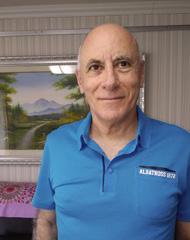
This is the latest monthly installment by Daniel Springer of the Gwangju Foreign Language Network (GFN), where “Danno” picks his favorite newly released tunes that you may have missed, along with some upcoming albums and EPs that you might want to keep on your radar.

This is a song that Koreabased Scottish expat artist David Skimming released last year as a standalone single, which was one of our glimmering surfooze favorites of last year. Eventually, the song would feature on Skimming’s third album in the past three years titled Right Way Round. Well now the song has gone worldwide, as a group of video producers and artists in Mexico City have given this beautiful single the visual treatment, making this song a lasting object of value far beyond these shores or the bedrooms of indie heads.

This Chicago-based band has such a distinctive and lush sound, with the combination of Julian Ehrlich’s falsetto pleading and the tender approach of the instrumentation creating a vibe that no other band around can match. This standalone is actually something the band started working on back in 2017, but it eventually morphed into the semi-titular track


“FTA” on their 2019 album Forever Turned Around. While touring the album later, Ehrlich and co decided to play the original as part of their sets, and it has since become a staple. As of August 11, this long-in-the-tooth single has finally gotten the studio release it so obviously deserved.
Since the release of their smashing debut album Prism in September of last year, the multihued siren trio of Piya Malik, Nya Gazelle Brown, and Sabrina Mileo Cunningham, and their extra tight band have been going from strength to strength with gigs at top-notch events and a slew of new songs. With this spaced-out funk adventure, the band have not only channeled their Chic Organization ethic to a tee but announced a sophomore double album. Silver drops exactly one year after their debut, on September 29.
For those unaware, this is the moniker of Bridgette Winten, who’s based in the audio supercluster of Melbourne, Australia. The song
above is the titular track to the artist’s debut album, which dropped August 18. Interestingly, for any of you vinyl addicts out there, the digital version of the album will be somewhat incomplete, with a couple of the joints therein only featuring on the wax. This is an interesting artist to keep an eye on, who only made debut last year.
If you were playing a 2023 in music bingo game and got this combo getting together for an EP, you’d have never thought your number was coming up. Of course, you’d be totally wrong. The hardcore, the jazz, and the R&B power evident here is remarkable, although it’s mostly invested in the latter. New Heart Designs is the product and well worth a listen, as all three entities involved leave their signature therein.
This is the work of Nat Ćmiel, who’s out of Singapore and set to release their debut album Softscars on September 22. A self-described “fourthgeneration goth,” the sound is an amazing meld of Asian post-pop influences, post-metal, and glitchy electronic. This single, released August 11, is an interesting trip into borderline schizophrenia, with a layered vocal track creating a sense of frenzy and desperation that is palpable. In a statement, the artist noted, “Love without obsession and an undying innocence, like shattered memories and floating so empty, finally, I am enfleshed after being so hollow.”

It’s been a long road to a debut album for Groves, who was born in West Yorkshire and now calls London home. August 11 saw the artist finally release Radio Red a full ten years since making debut with what is still Groves’ only EP release. This haunting number features the elusive yet always alluring Sampha on the cut, and we cannot recommend giving the record a full spin highly enough. Of course, you’d be showing some love for a very deserving and hard-working artist in the process.
Heads have rolled at Drop Central for missing this incredible EP earlier this year in April. After releasing an amazing debut LP in 2021 titled Under Twenty Five, this tune is part of the follow-up six-song EP, We Go Again. Back in 2022, the Nigerian-born and London-raised artist was cited in BBC’s Sound of 2022, and it looks like the fire is going to continue to fuel this artist to stardom in the manner of artists back in the Lagos surrounds like Burna Boy.



Nobody does dejection and hopelessness quite like our Asian-American femme power superhero known to the public as Mitski , and this joint punctuated by massive choral peaks is notable just for the punches. Of course, that’s not all, as this is the lead single to Mitski’s upcoming album The Land Is Inhospitable and So Are We, which drops in full on September 15.


This Canadian artist has a bit of a habit of making tunes that seem to catch the moment and go viral every so often, and this latest effort is mostly a lay-low, go-slow kind of cut, but the hard electric strum punctuations on the guitar add a manic energy that feels like shock therapy. This tune is the latest in a series of singles released from the artist’s third career studio LP Wisecrack, which is due for release September 15.
Daniel J. Springer (aka “Danno”) is the creator, host, writer, editor, producer, troublemaker, and Mr. Fix It of “The Drop with Danno,” broadcasting weeknights on GFN 98.7 FM in Gwangju and 93.7 FM in Yeosu from 8–10 p.m. Prior to this, he was a contributor to several shows on TBS eFM in Seoul, along with being the creator and co-host of “Spacious” and “White Label Radio” on WNUR in Chicago.

Instagram, Twitter, Facebook: @gfnthedrop Show RSS Feed: https://feeds.transistor.fm/the-dropwith-danno
Mammoth WVH – Mammoth II (August 4)
Art School Girlfriend – Soft Landing (August 4)
Les Imprimés – Rêverie (August 11)
Laura Groves – Radio Red (August 11)
Jungle – Volcano (August 11)
Turnstile, BadBadNotGood, & Blood Orange – New Heart Designs (EP) (August 11)
The Hives – The Death of Randy Fitzsimmons (August 11)

Cautious Clay – KARPEH (August 18)
Osees – Intercepted Message (August 18)
Genesis Owusu – Struggler (August 18)
Hozier – Unreal Unearth (August 18)
Pale Jay – Bewilderment (August 18)
The Armed – Perfect Saviors (August 25)
Buck Meek – Haunted Mountain (August 25)
Field Medic – Light Is Gone 2 (September 1)
Slowdive – Everything Is Alive (September 1)
Allison Russell – The Returner (September 8)
Courtney Barnett – End of the Day (September 8)
Yussef Dayes – Black Classical Music (September 8)
James Blake – Playing Robots into Heaven (September 8)
Olivia Rodrigo – Guts (September 8)
Mitski – The Land Is Inhospitable and So Are We (September 15)
Haley Blais – Wisecrack (September 15)
Vagabon – Sorry I Haven’t Called (September 15)
Nation of Language – Strange Disciple (September 15)
Pale Blue Eyes – This House (September 15)
Devendra Banhart – Flying Wig (September 22)
Chai – Chai (September 22)
Yeule – Softscars (September 22)
Slaughter Beach, Dog – Crying, Waving, Laughing, Smiling (September 22)
Say She She – Silver (September 29)
Jorja Smith – Falling or Flying (September 29)
Blonde Redhead – Sit Down for Dinner (September 29)
Cherry Glazerr – I Don’t Want You Anymore (September 29)
Slow Pulp – Yard (September 29)
Buck Meek – Haunted Mountain (August 25)
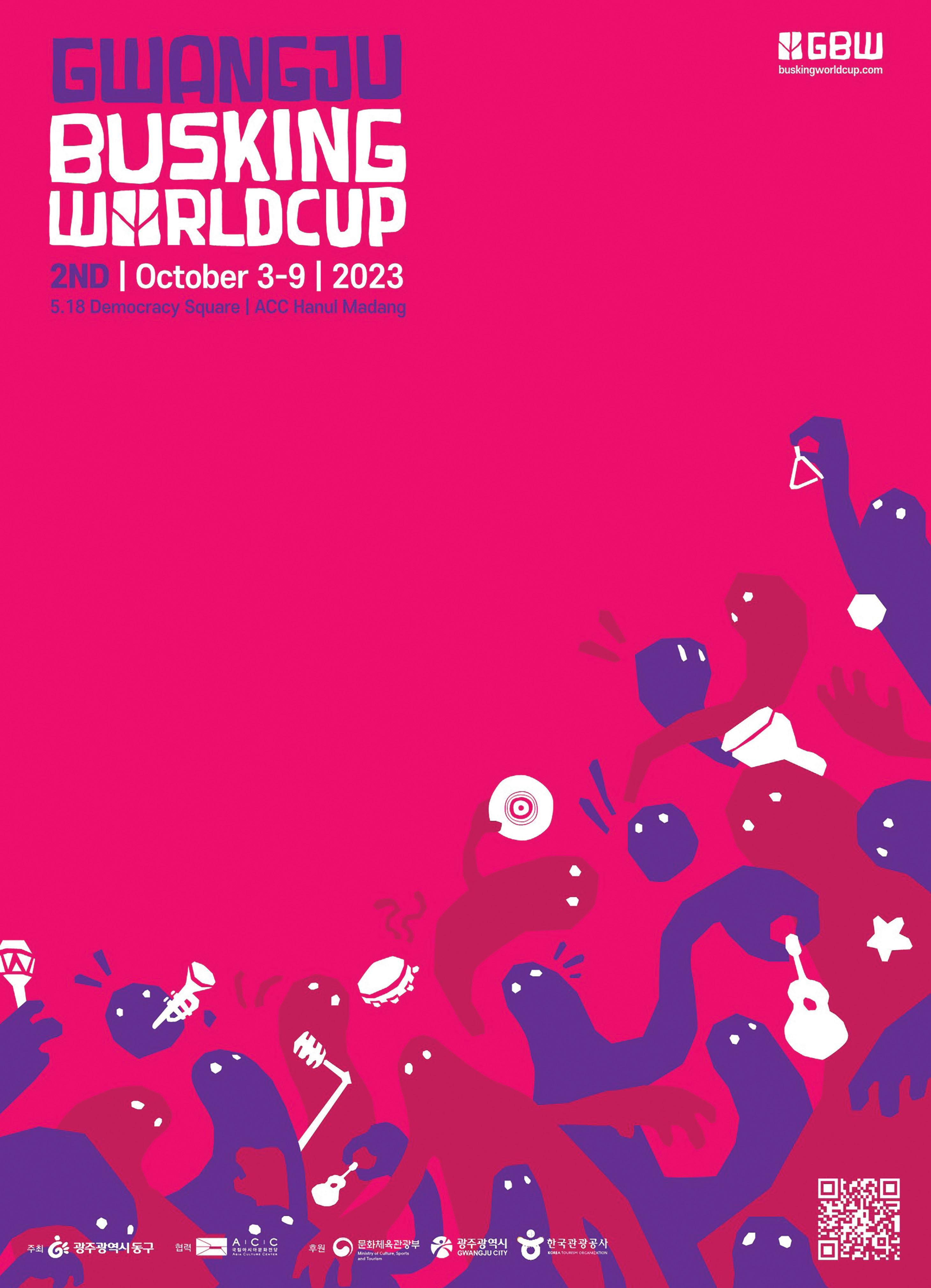
through Kakao Talk Plus Friend “GIC광주국제교류센터.” Add us now! :)
Mon. – Sat. 10 a.m. – 6 p.m.
Lunch hours 1 p.m. – 2 p.m.
community culture exchange communication sharing
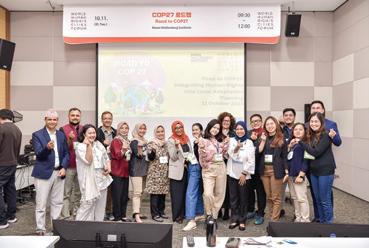
For only 50,000 won/year, you help the GIC provide a space for exchanges for the local and international communities to learn and experience various cultures from around the world and to promote respect for diversity and inclusivity.
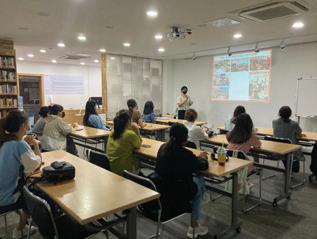

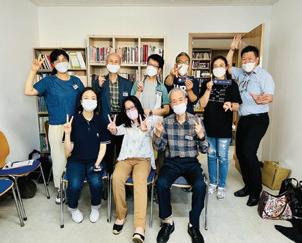


Bene�its as a GIC member:
Receive the Gwangju News every month by email. Priority for participation in programs. Get discounts on paid programs and space rentals.
Borrow books and materials from the GIC Library. Get receipts for contributions provided for year-end tax settlement.
(61475) 5 Jungang-ro 196-beon-gil (Geumnam-ro 3-ga), Dong-gu, Gwangju, Korea Tel. 062-226-2732 Email. gic@gic.or.kr Web. www.gic.or.kr